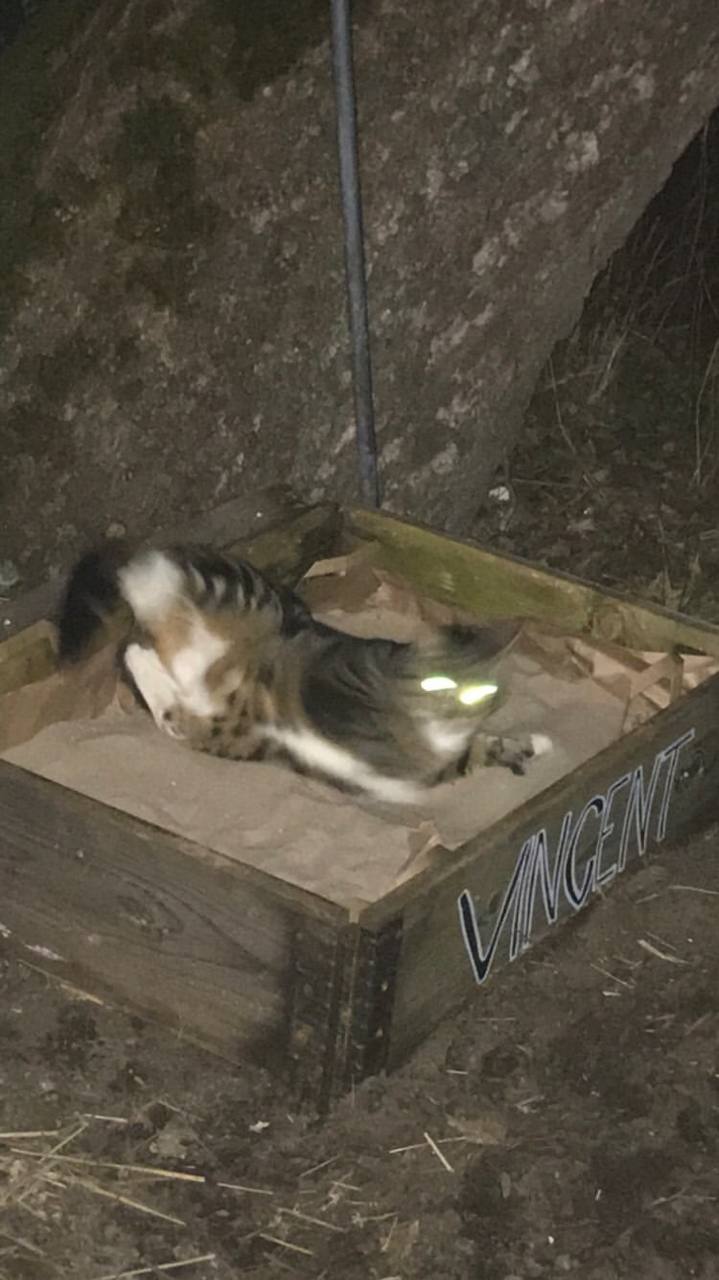SV Pihalla är ett projekt som växer på Pro Artibus residens Villa Snäcksunds gård. För sitt sista halvår på Snäcksund har residenskonstnär Corinna Helenelund och hennes partner Lukas Malte Hoffmann bjudit in kollegor att besöka Snäcksund, dela tankar och arbetsprocesser, och skapa verk för gården. Det finska uttrycket pihalla (bokstavligen ”på gården”) har i dagligt tal betydelsen att vara vilse, att inte hänga med. Att vara vilse eller inte förstå, kan i perioder vara en vardaglig del av det konstnärliga arbetet och locka till att gräva djupare, förstå på nya sätt, eller ibland låta sig gå ännu mer vilse. Denna sida är en logg som digitalt följer med vad som utspelar sig på gården.
FI ”Pihalla” on projekti, joka kasvaa Pro Artibuksen Villa Snäcksund-residenssin pihaympäristössä. Residenssitaiteilija Corinna Helenelund ja hänen kumppaninsa Lukas Malte Hoffmann ovat kutsuneet Snäcksundiin kollegoja jakamaan ajatuksia ja työskentelyprosesseja sekä luomaan pihalle teoksia. Projektin nimi viittaa paitsi sijaintiin myös sanan puhekieliseen merkitykseen: ymmällä olemiseen. Pihalla tai eksyksissä oleminen voi toisinaan olla osa taiteilijan arkea. Se saattaa houkutella kaivautumaan syvemmälle, ymmärtämään asioita uudella tapaa tai antamaan itselle luvan eksyä vieläkin enemmän. Tämä sivu on loki, joka seuraa pihan tapahtumia digitaalisesti.
EN Pihalla is a project that grows in the yard of Villa Snäcksund, Pro Artibus’ 3 year residency in Ekenäs. During their last 6 months in residence, resident Corinna Helenelund and her partner Lukas Malte Hoffmann have invited fellow colleagues to visit Snäcksund, to share thoughts and work processes, and to make works for the yard. In Finnish common use the expression ‘pihalla’ (literally ‘in the yard’) means being lost or not following. In artistic work this condition of being lost or not to understand can at times be very present, tickling wishes to dig deeper, understand in new ways, or to get even more lost. This page accompanies the project digitally, logging what is happening in the yard.
Contributions by (in order of appearance):
Katie Lenanton
Susan Kooi
Livio Casanova & Polly Wright
Æpis (Espen Melin Hagedorn & Alice Peragine)
@chonkymoomin_
Anastasiia Sviridenko
Matti Gajek
Savu E. Korteniemi
An offering for infinite happiness (Part 1/2)

by Katie Lenanton
In 2021, huhtasieni [morel mushrooms] sprouted amongst the woodchips of Snäcksund’s garden, pihalla [in the yard]. This shroom is rarely found in Finland, but apparently enjoys symbiotic relationships with abandoned apple orchards, old oak trees, and forest areas recovering from fire. When I heard that Lukas and Corinna were living in Tammisaari [Oak Island] and their housemate Meri had spotted morels the previous year, my mushroom radar started tingling. My enthusiastic response to this news evidently made an impression, and I was invited to visit.
The first trip in late April was mushroom-free, the ground still frozen with no sign of spring. A month later the forest was carpeted with growth, and we found many early green buds—fireweed, horsetail, meadowsweet, lady’s mantle, wood sorrel, bishop’s weed—and one solitary oyster mushroom filled with worms.


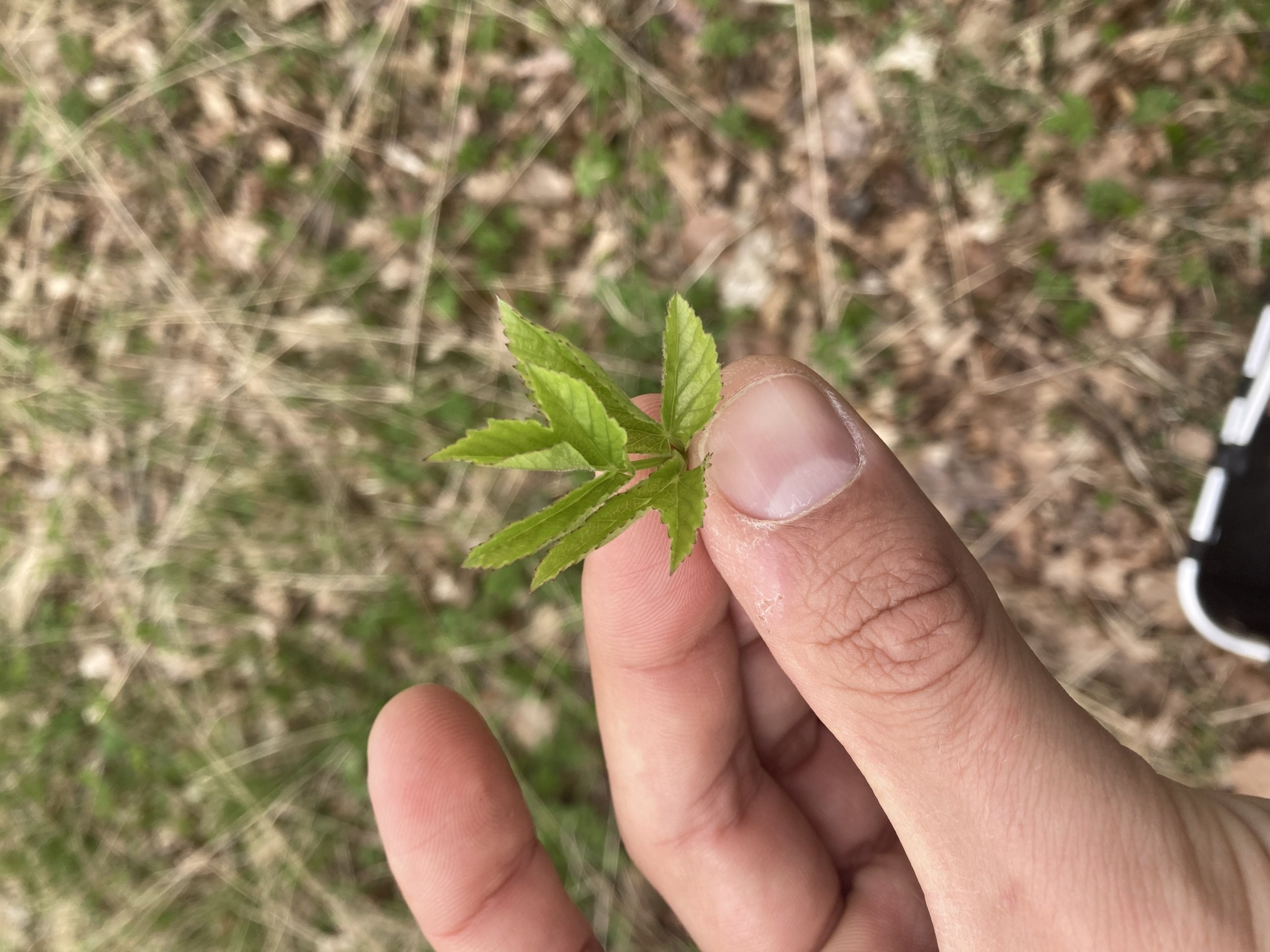

Residencies often put forward the invitation to engage with local communities and contexts, albeit within quite limited timeframes. A Pihalla response grounded in foraging and wildcrafting made sense to me in this mini-residency hosted within a residency. At Snäcksund, I began reflecting on how to wield energy, effort, aloneness, and presence. I read about wildcrafting and alchemy, understanding plants as friends rather than commodities to be harvested. I practised an ethics of gathering in which the act of foraging involves saying thank you, taking only what’s needed, and finding forms to honour, share, and celebrate the harvest. Also resonating was the ecofeminist tenet of food production as an act of gift-giving and exchange, a practice that counters patriarchal, oppressive and exploitative capitalist food production systems. On this second visit we gathered and cooked together, and I collected juniper, pine, and rowan buds for infusions, leaving these gifts for the house to develop. And my furry companion Snoozle met deer for the first time, and will never be the same.


Last year I learned about attitudes towards luck and happiness through a Finnish anthropological lens. After a forest walk in which I’d excitedly tried to discuss the contents of my mushroom basket with a stranger on the same path, only to be met with a stoic and silent nod, a friend sent me this text. It puts forward the belief that happiness is finite and can be stolen if visibly expressed. So sharing happiness about a mushroom haul is to risk losing the mushroom luck to a jealous stranger. I also learned that phenomena like luck—or feelings like happiness or jealousy—could be transferred into objects whose spirits might be cajoled into doing one’s bidding. From one artist I learned the term para for these spirit creatures, while other friends (and the Mustarinda Residency house) have introduced to me the idea of building relationships with different tontut [elves]. I’ve since been chatting to and thanking the metsätontut [forest elves] every time I take a walk, but now I’m wondering if my previous year’s mushroom happiness is with that other person on the path for now…
MIDSUMMER FLAG
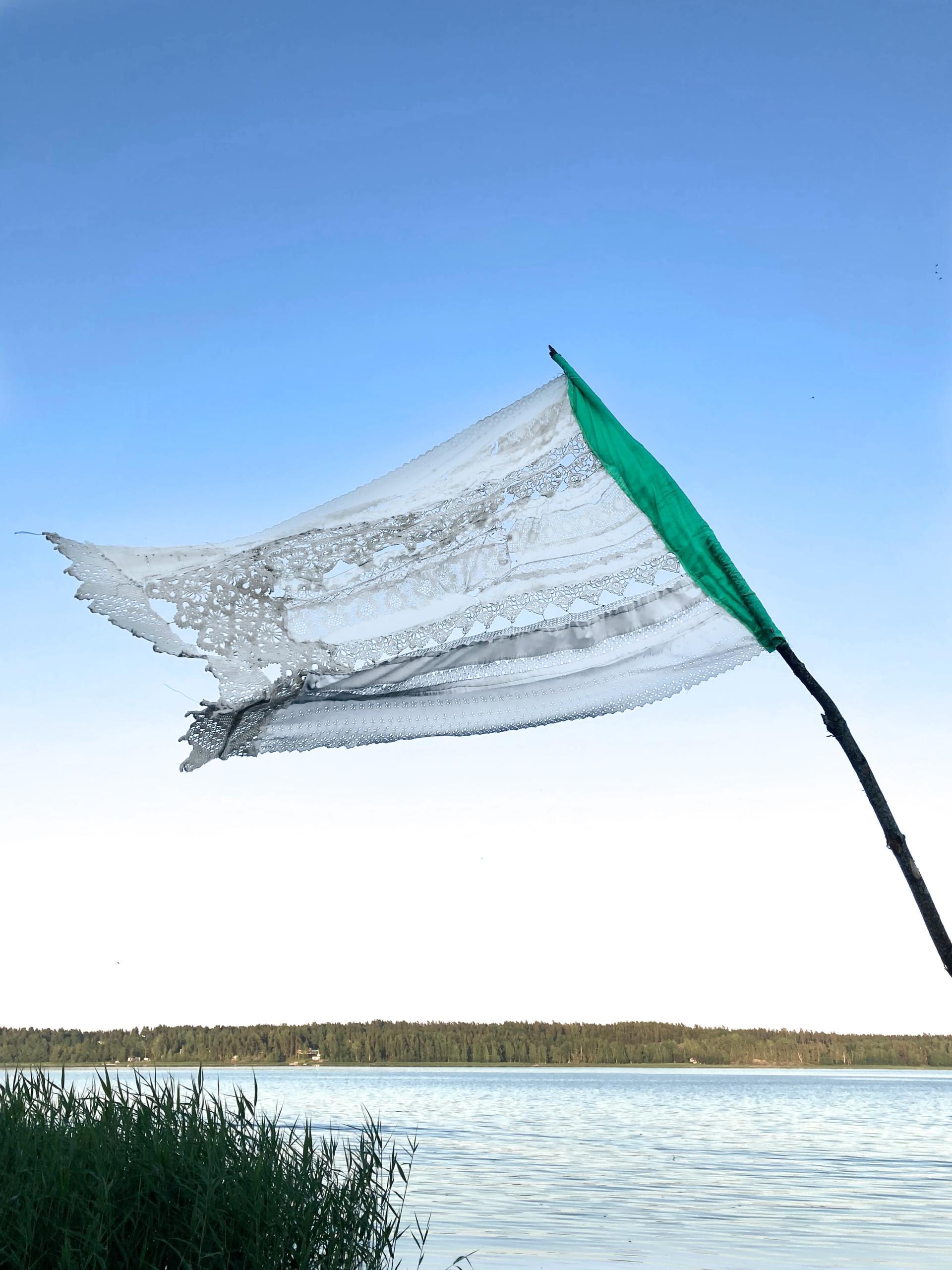
by Susan Kooi
mixed textiles, 230 x 120 cm
This is my second time in Tammisaari. The first time it was full-on winter, with temperatures dropping to -20 and the amount of snow where you lose your shoes in. Lukas and I worked on a project called ‘Midsummer Rose’ back then, where we recreated the summer of 2020 by growing the green-white juhannusruusu with the help of growing lights. Now I am back here during the actual midsummer. This time working on a flag for the pole in the garden. The flag is composed of fabrics found in flea markets in Amsterdam, where I live, and in Tammisaari, where I am visiting. This season is giving it her all too, with lush green and endless sunny days. Lukas asked me the grande question: which season is better? Now it seems summer, but in the winter it seemed winter. The grass is the greenest here, and the whitest there. (Susan Kooi)
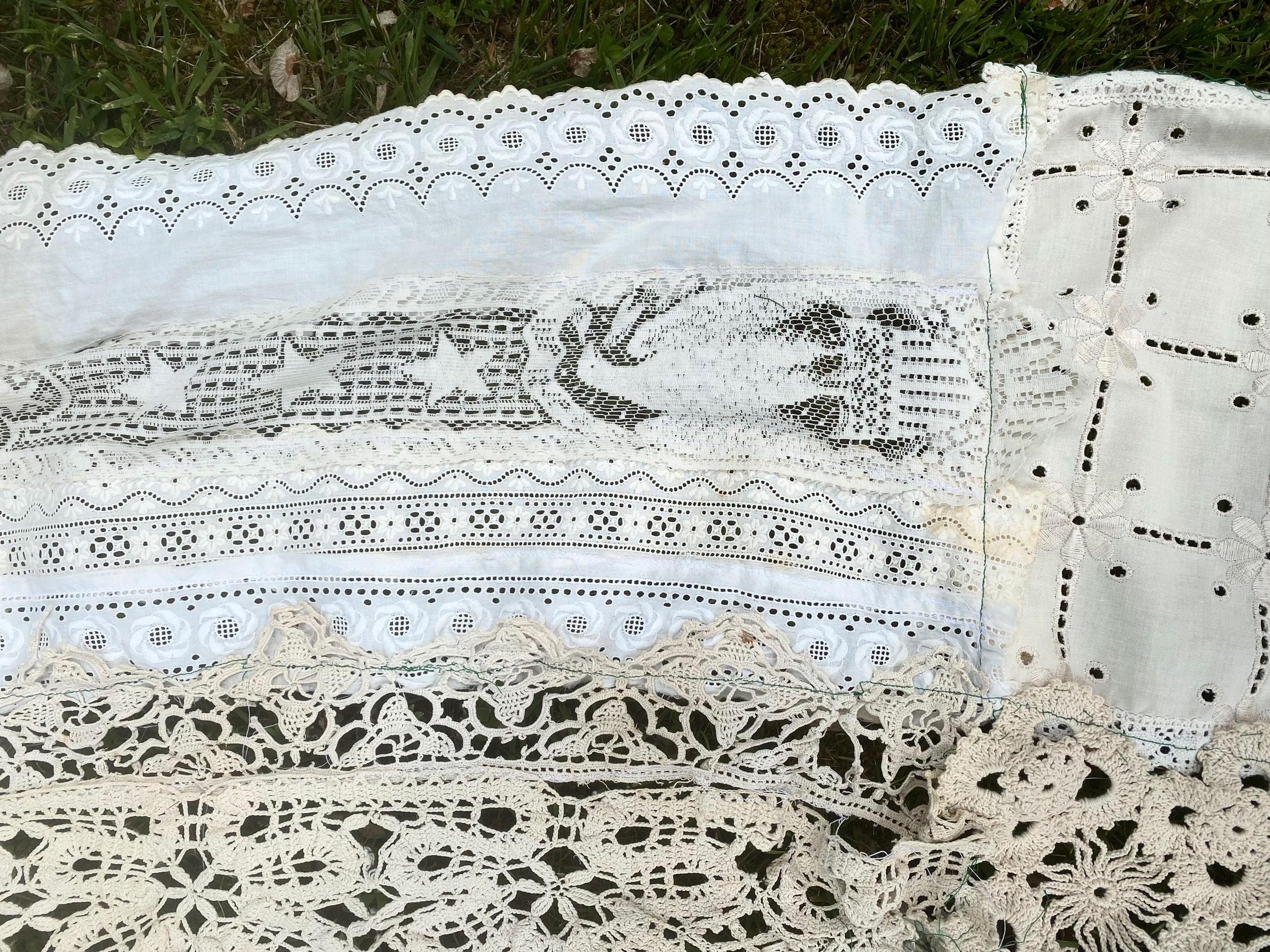
”The flower bloomed and faded.
The sun rose and sank.
The lover loved and went.
And what the poets said in rhyme, the young translated into practice.”
– Virginia Woolf, Orlando
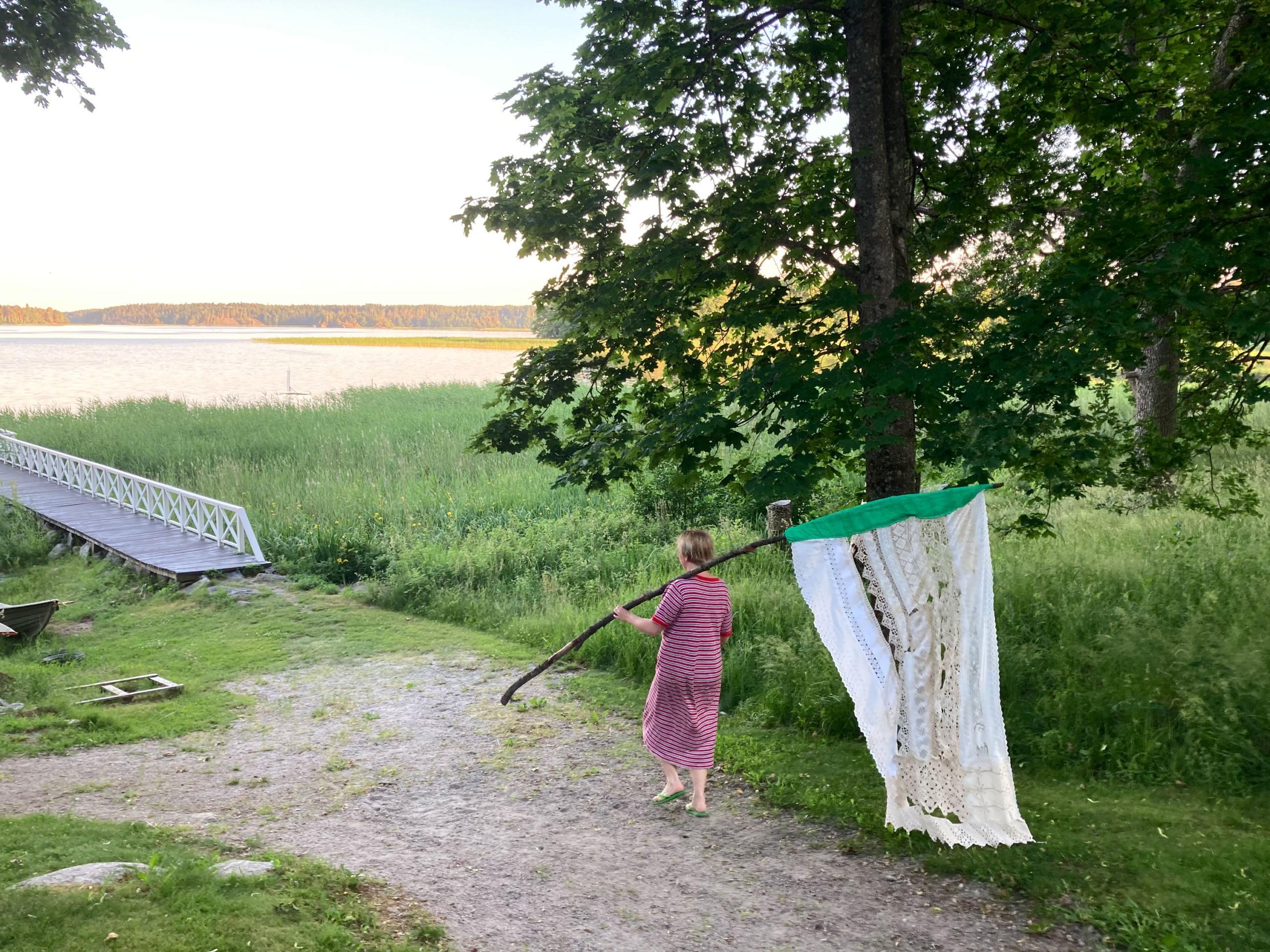

A FLOAT ING
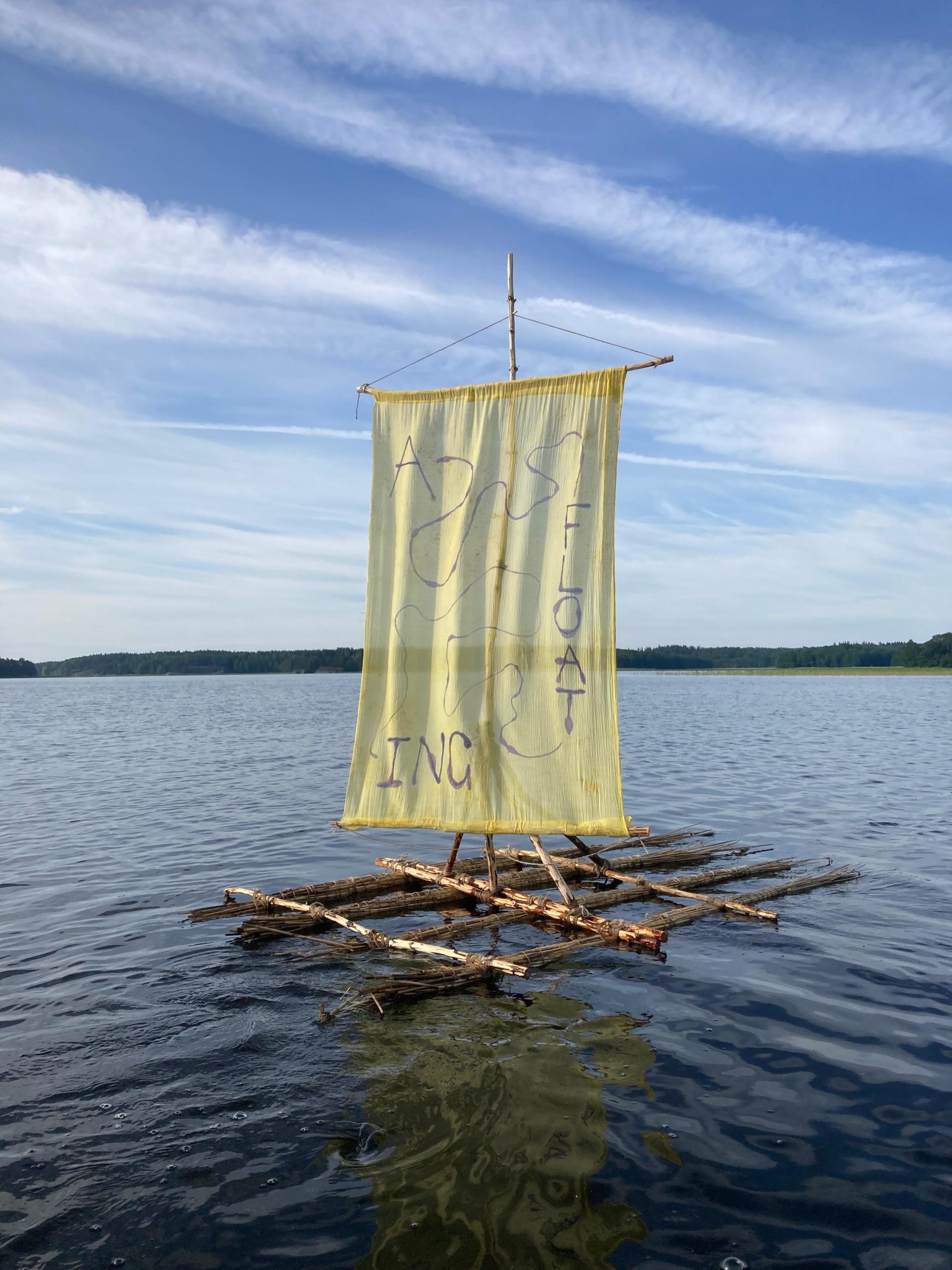
by Livio Casanova, Polly Wright and Lukas Malte Hoffmann
Reeds, hemp cord, cheesecloth, turmeric, ink, poems. Variable dimensions
Livio and Polly had bought tickets to Snäcksund for April 2020. That was, of course, before we knew that the world would turn itself upside down. We said, in good hope, that we’ll meet soon; possibly later in summer they would be here. Then summer came and of course they weren’t able to be here; the world was going to shits. However, it also seemed as if they didn’t remain ‘there’ either. For me, it felt that they were on their way here the whole time, for two and something years. Straight connection turned into jiggly lines, being pushed and pulled by time.
In the fullest sunsets, I would be walking down to the jetty in my crocs, a wait ing. (Lukas Malte Hoffmann)
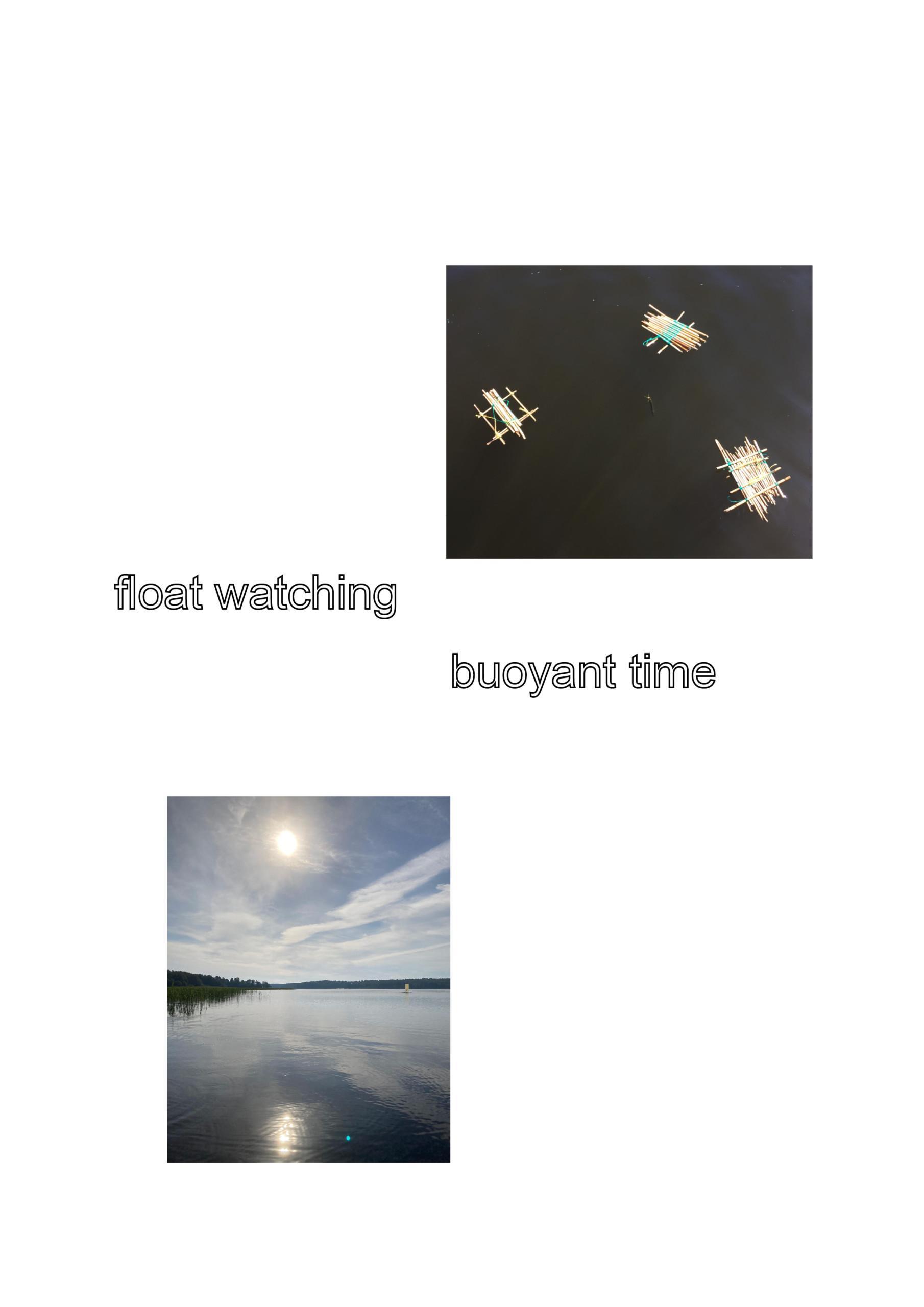
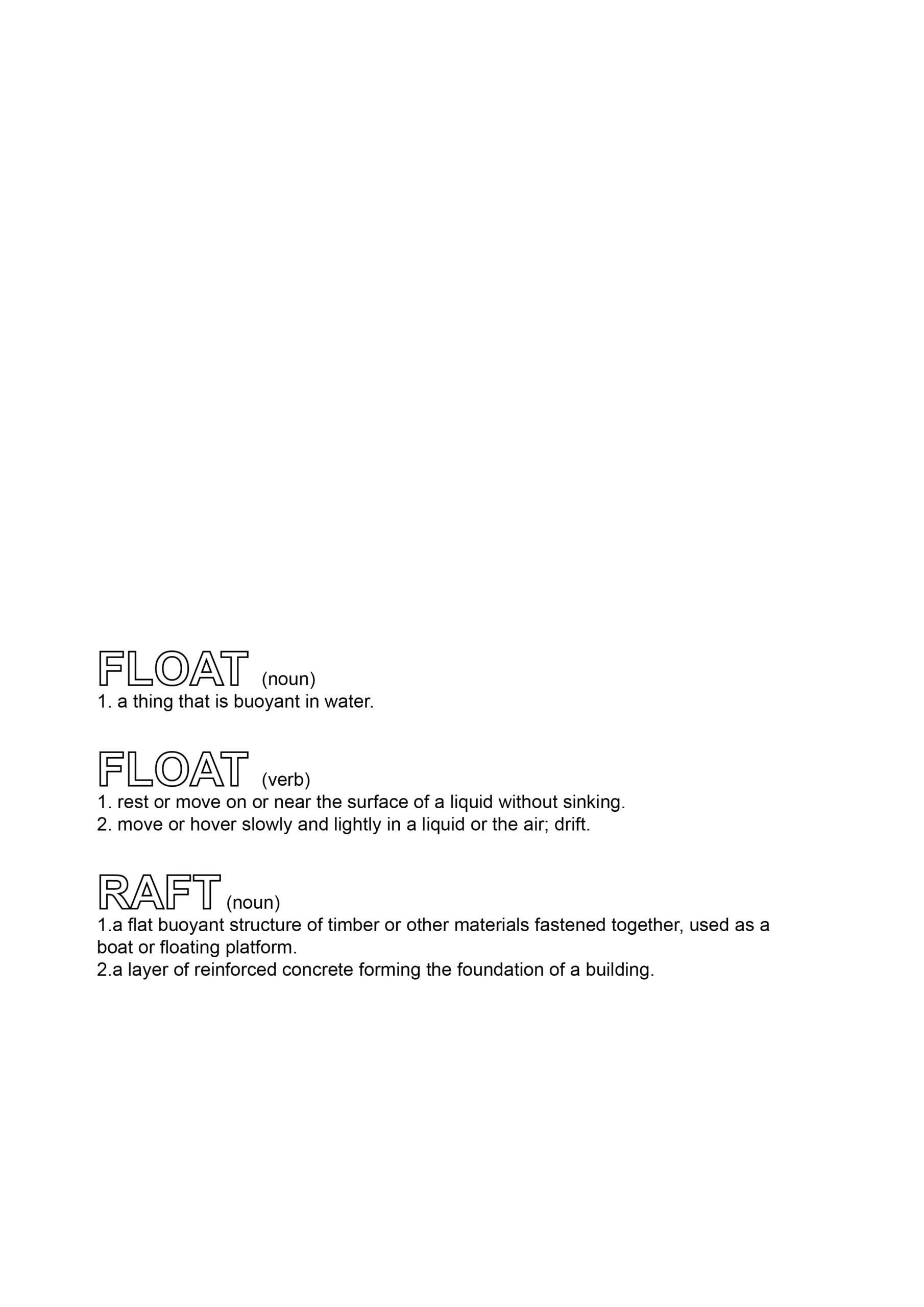
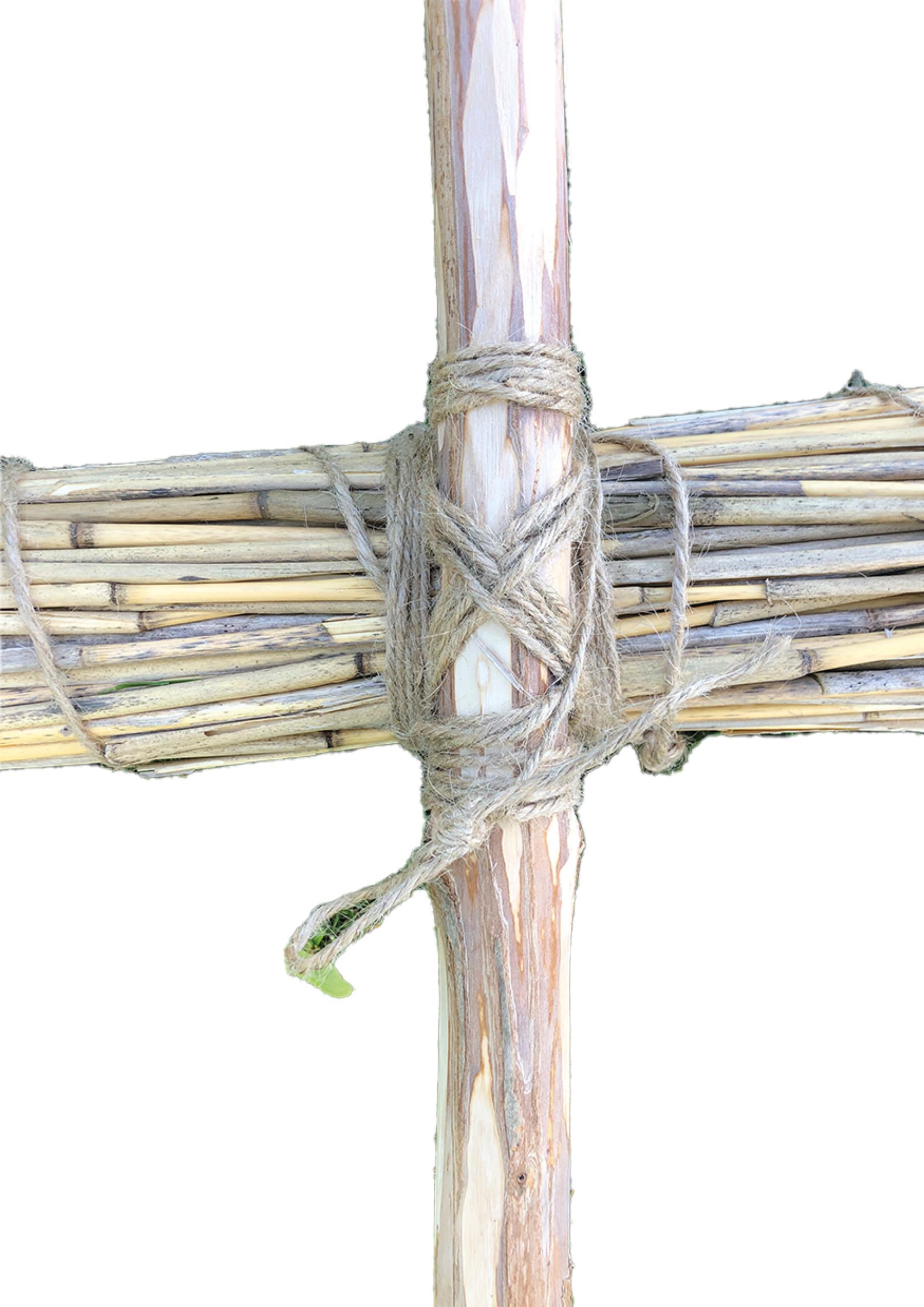

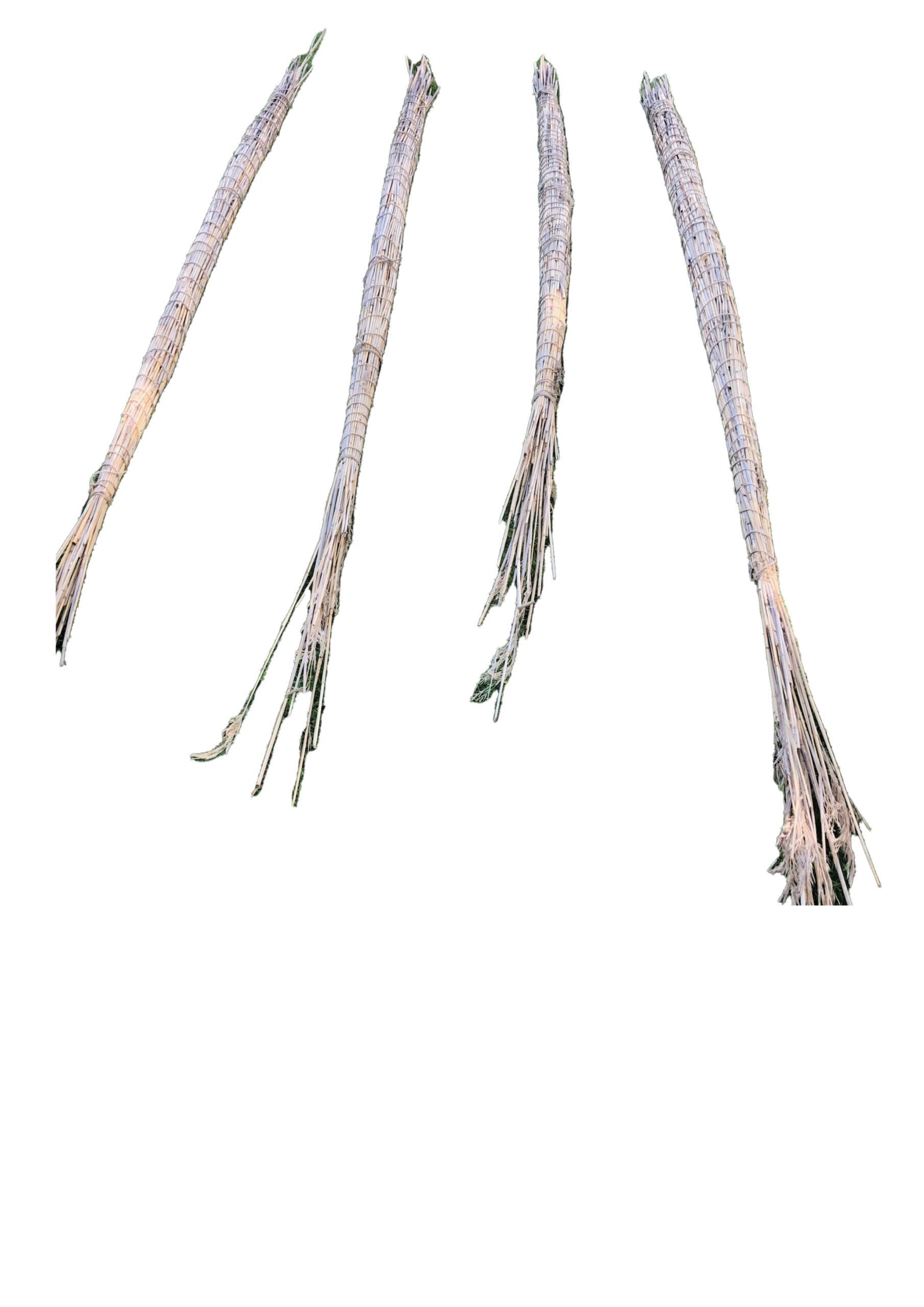
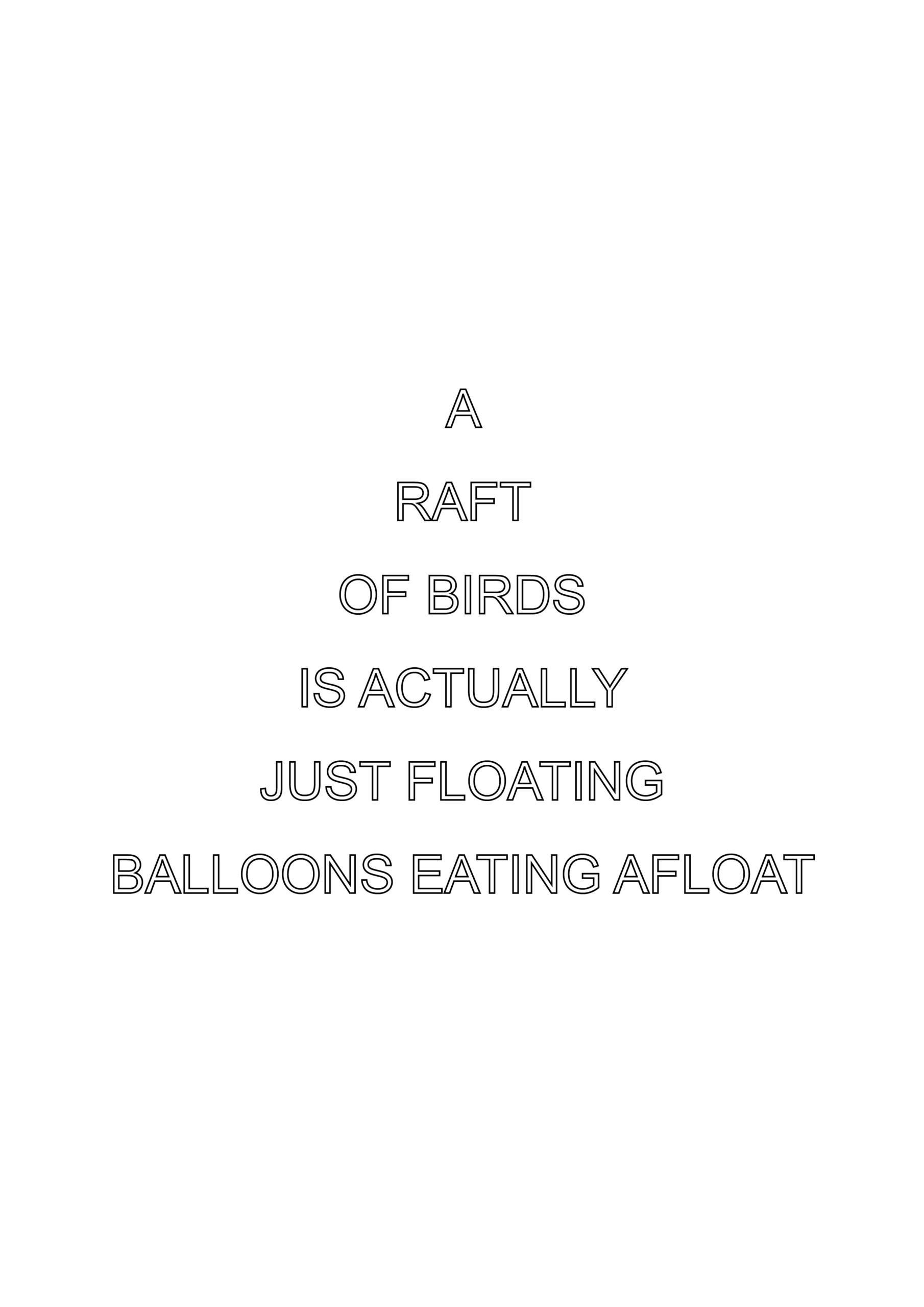
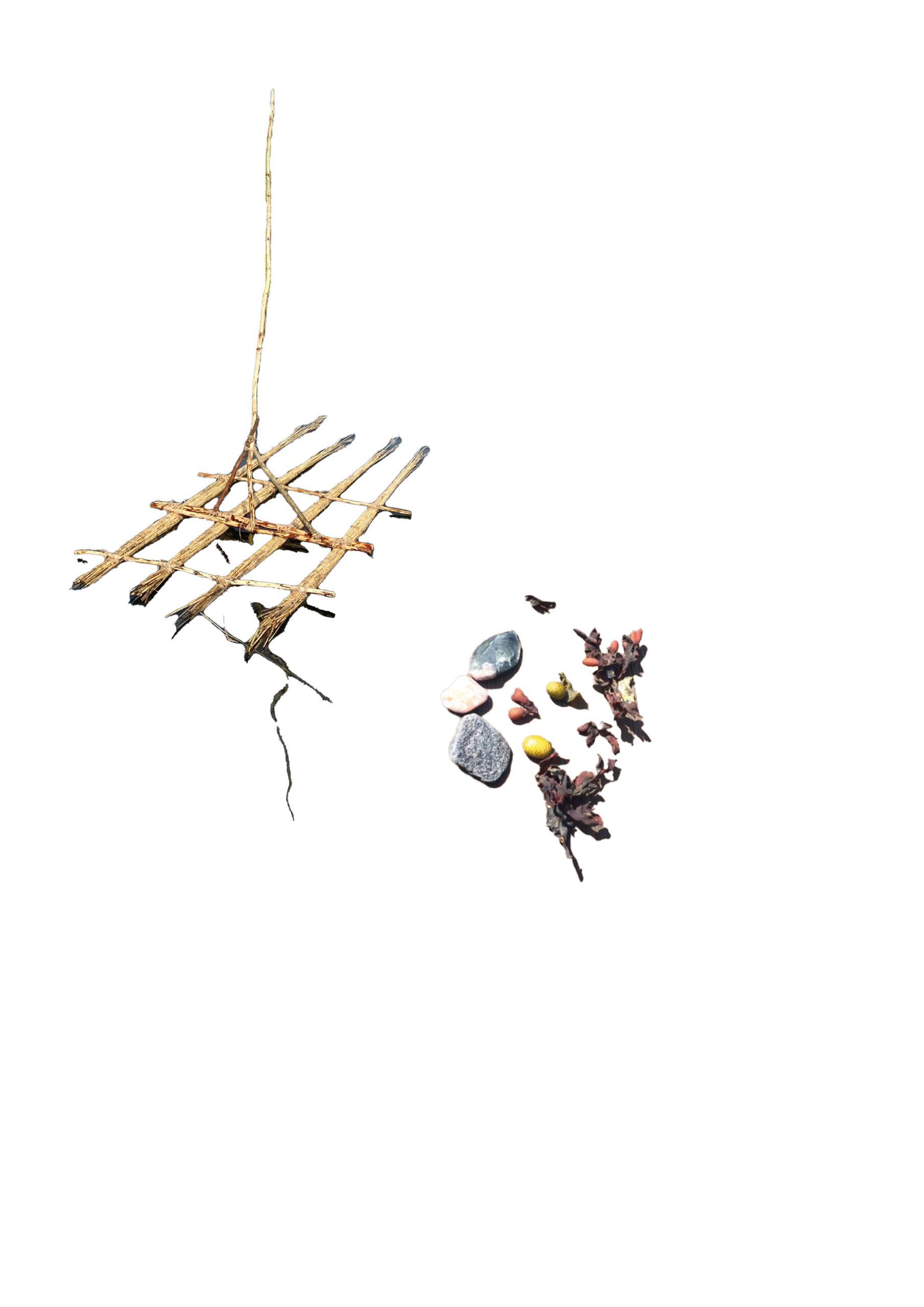


WALKING LIGHTLY ON THE EARTH
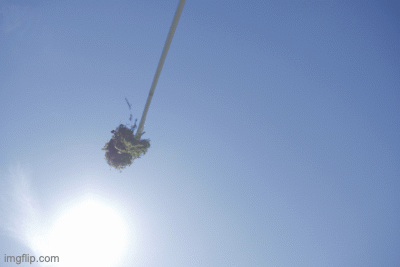
by Æpis (Espen Melin Hagedorn and Alice Peragine)
Installation and Activation
For the performance Walking lightly on the Earth* (2022), at Villa Snäcksund, Æpis gathered found materials from the grounds around the Villa and by the water, constructing provisional wearables made out of reeds, wood, thread and wires. These wearable objects are meant to remain as traces from their activation ceremony, held on Thursday August 4th 2022 as installations in the hut by the water and the green house in the garden until the end of the year 2022. During the activation, Æpis carried themselves lightly from the bridge by the water towards the garden swaying their bodies in the wind like reeds, singing and imitating the sounds of the motorboats passing by. A Seaweed animal crawled along the bridge to the greenhouse to gather and serve smashed cucumber fragments as a light meal. (Æpis)
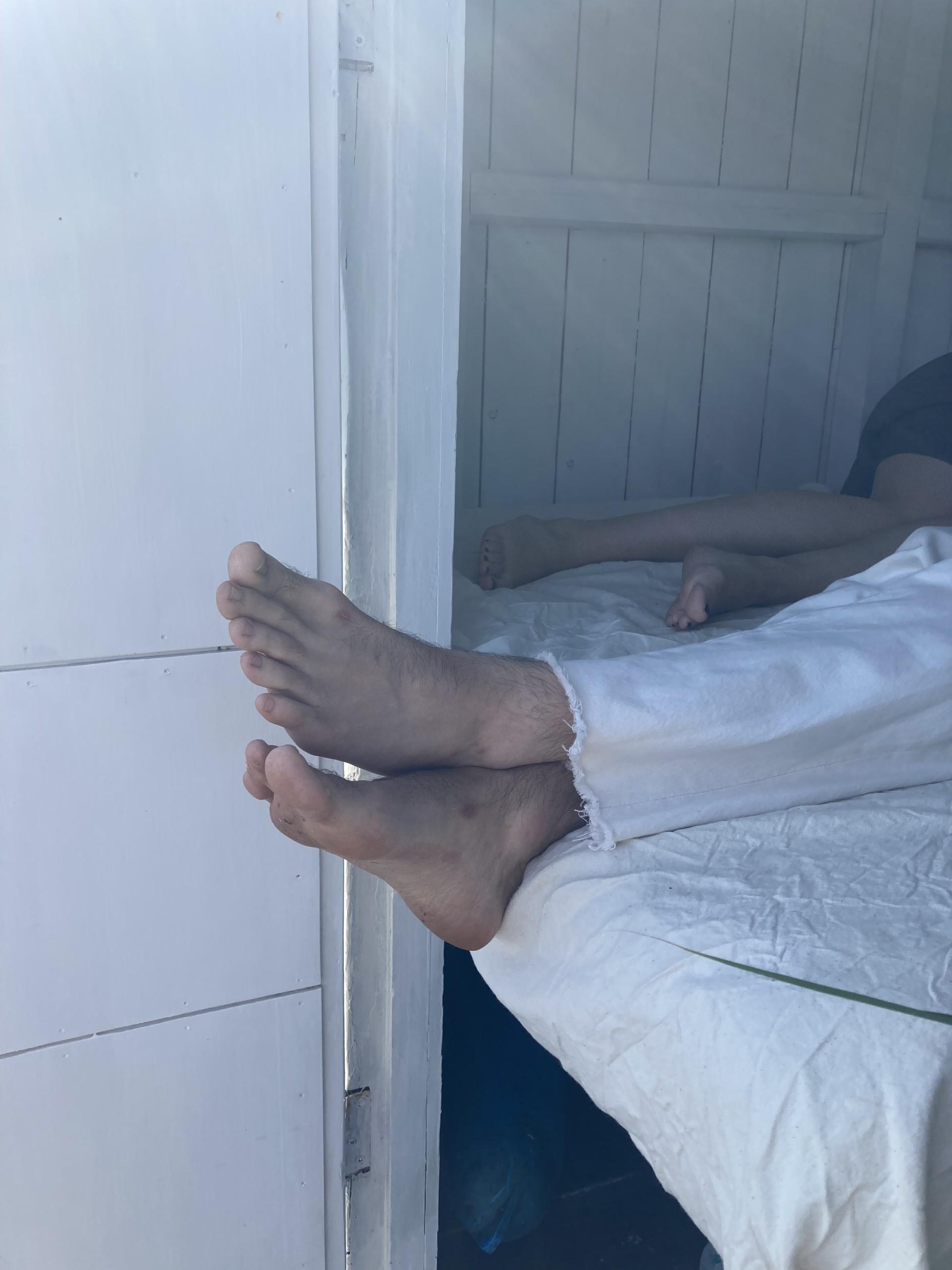
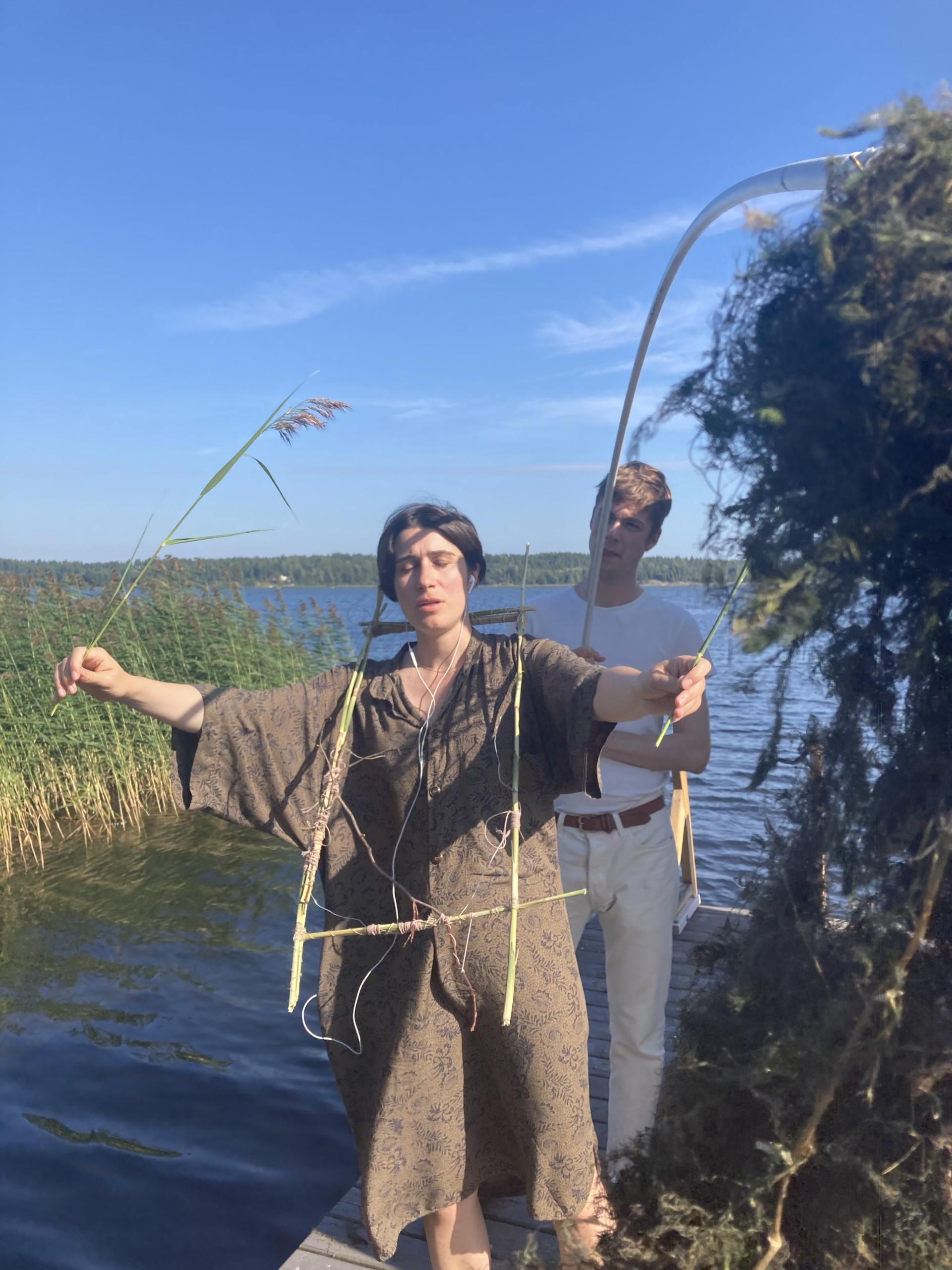

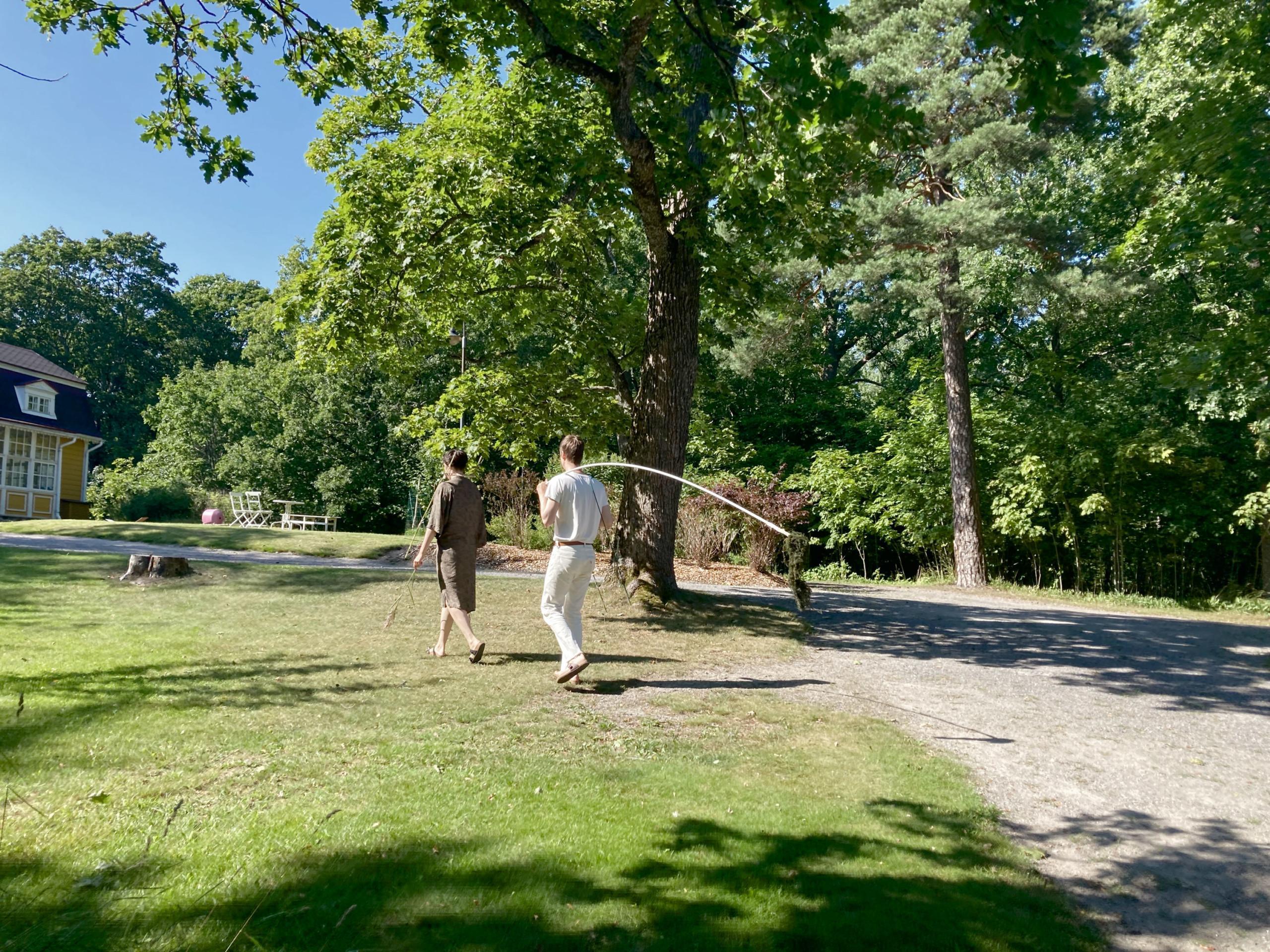
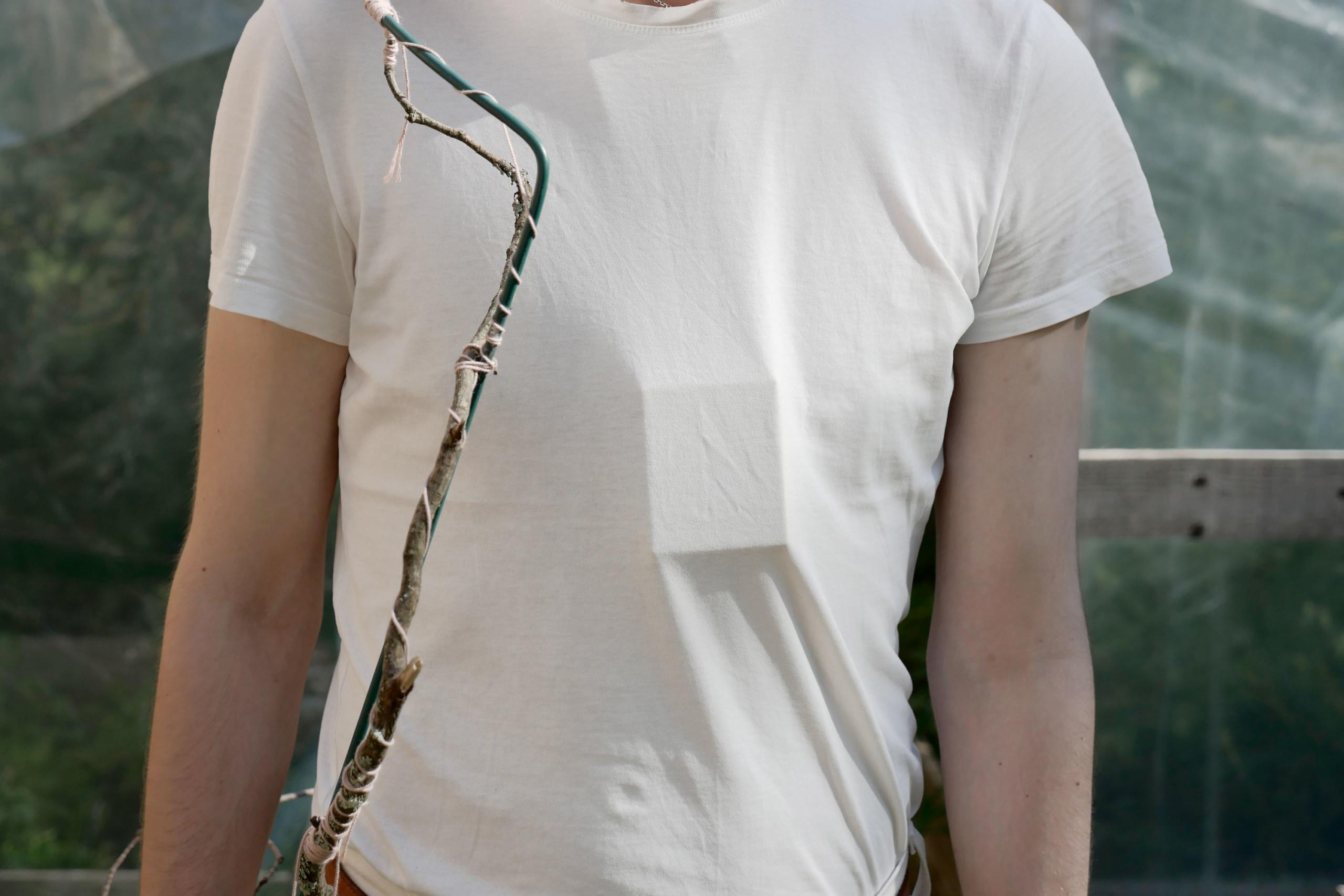
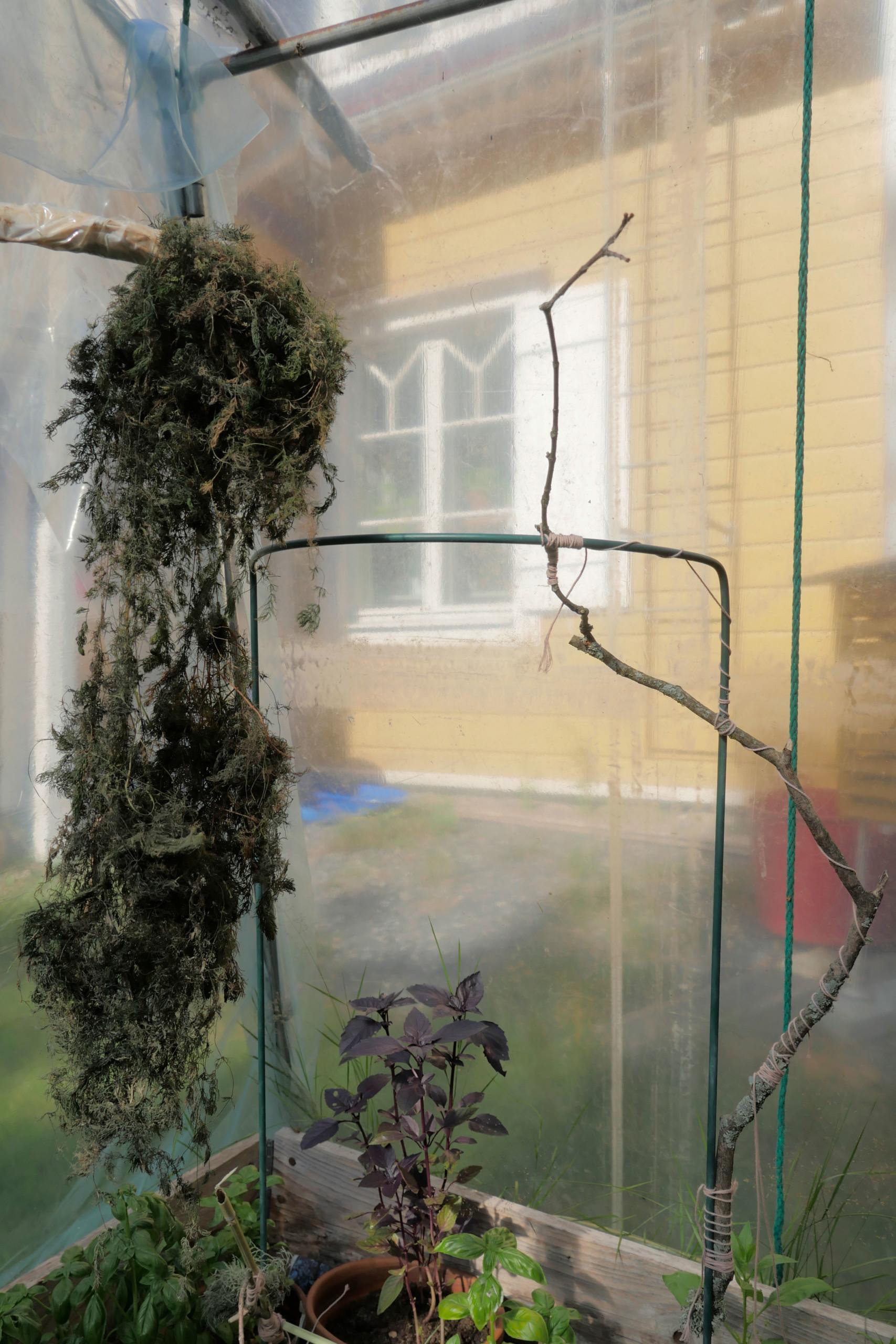
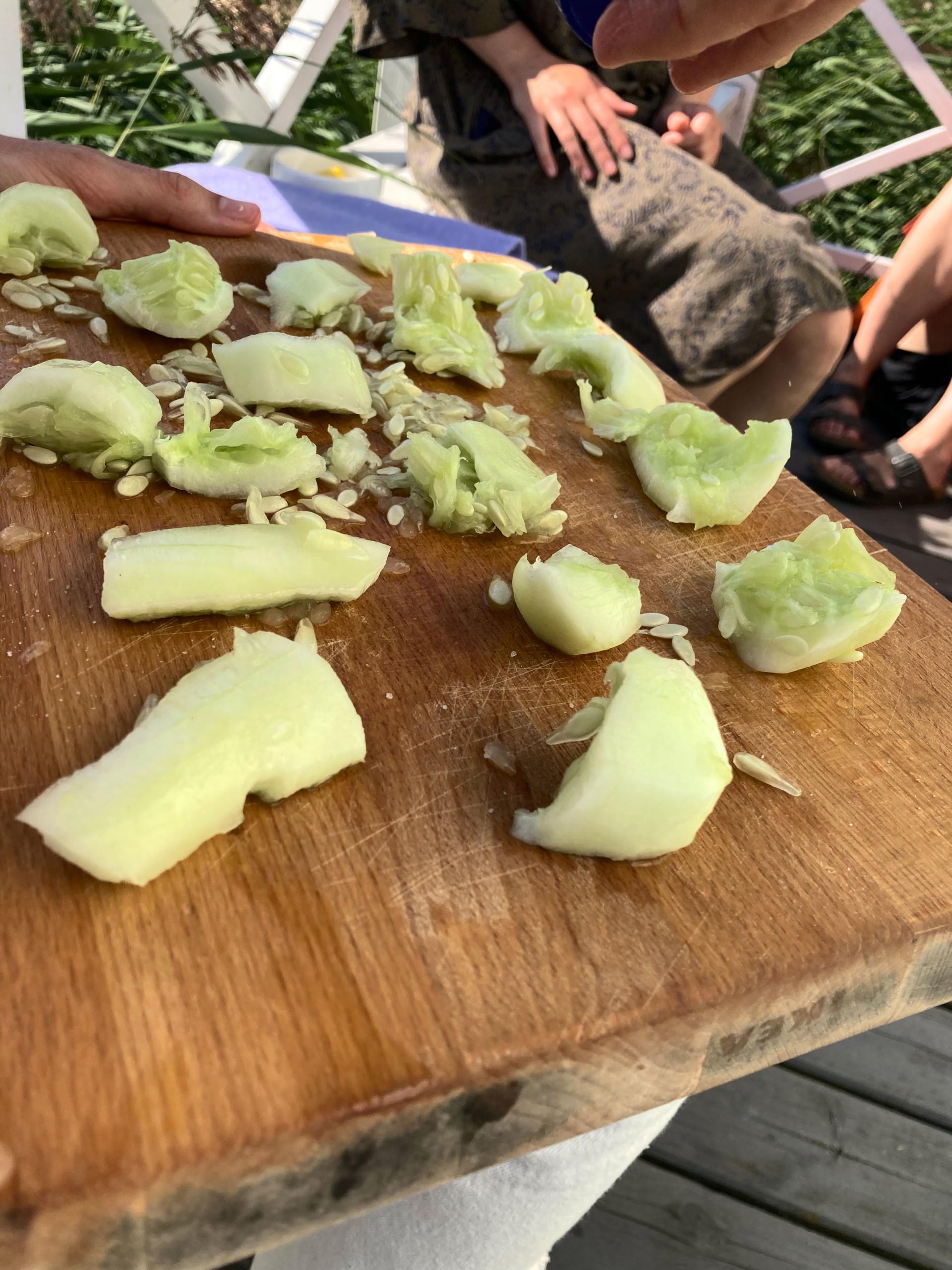
WELCOME TO THE PLUSH COMMUNITY
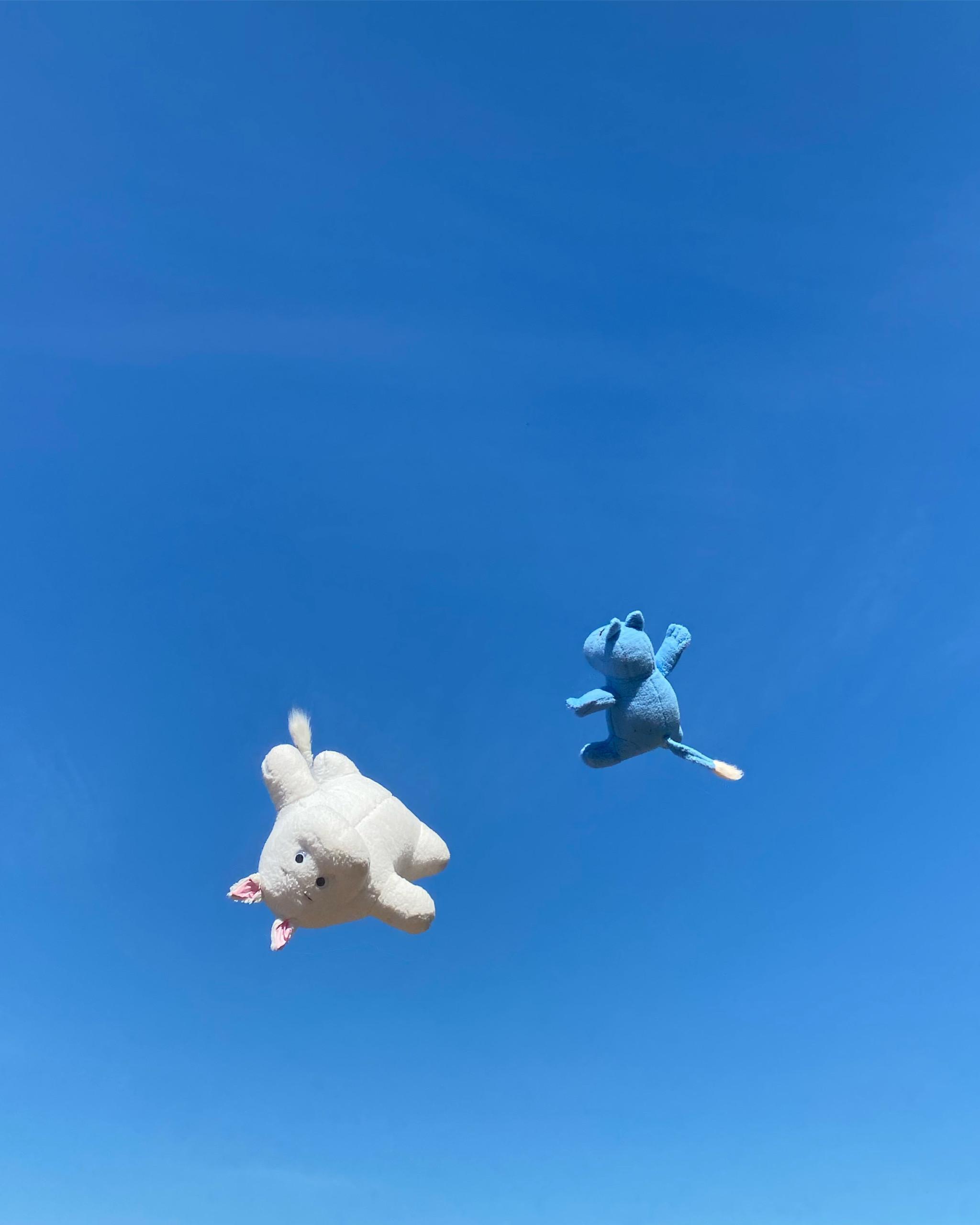
In the loppis in Karis there lived two homemade moomin plushies: one chonky white moominmama, and a baby blue moomin. We don’t know anything about their lives before the thrift store. We do know they got taken to Tammisaari, to live the dream moomin lifestyle. Hanging out on rocks, sleeping in the sun, going to sauna. But at some point they got bored, feeling mökki fatigue, so they packed their bags and got ready for their next adventure: moving to … Amsterdam! They are active on instagram, being popular in the #plushcommunity. (Susan Kooi)

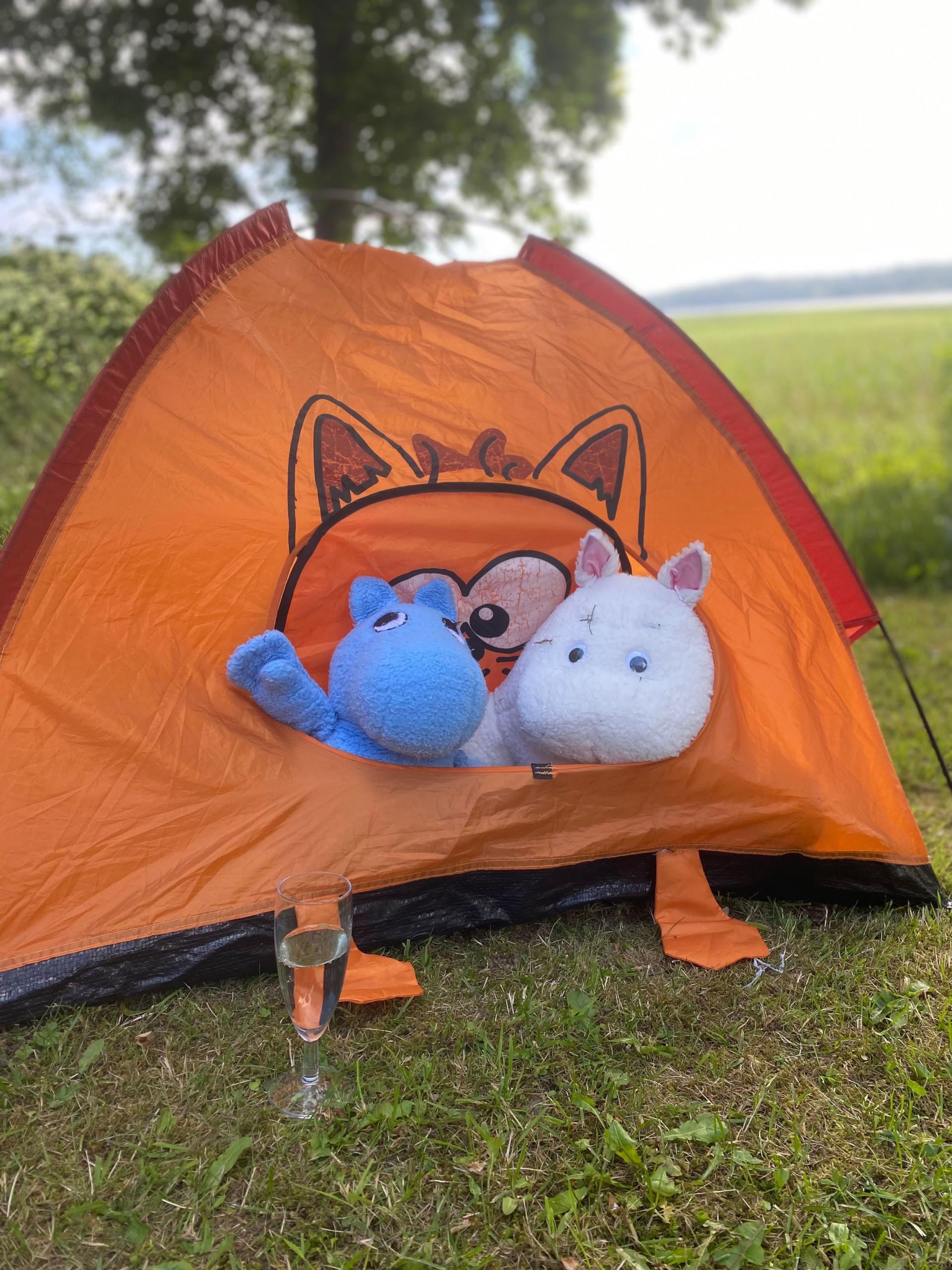
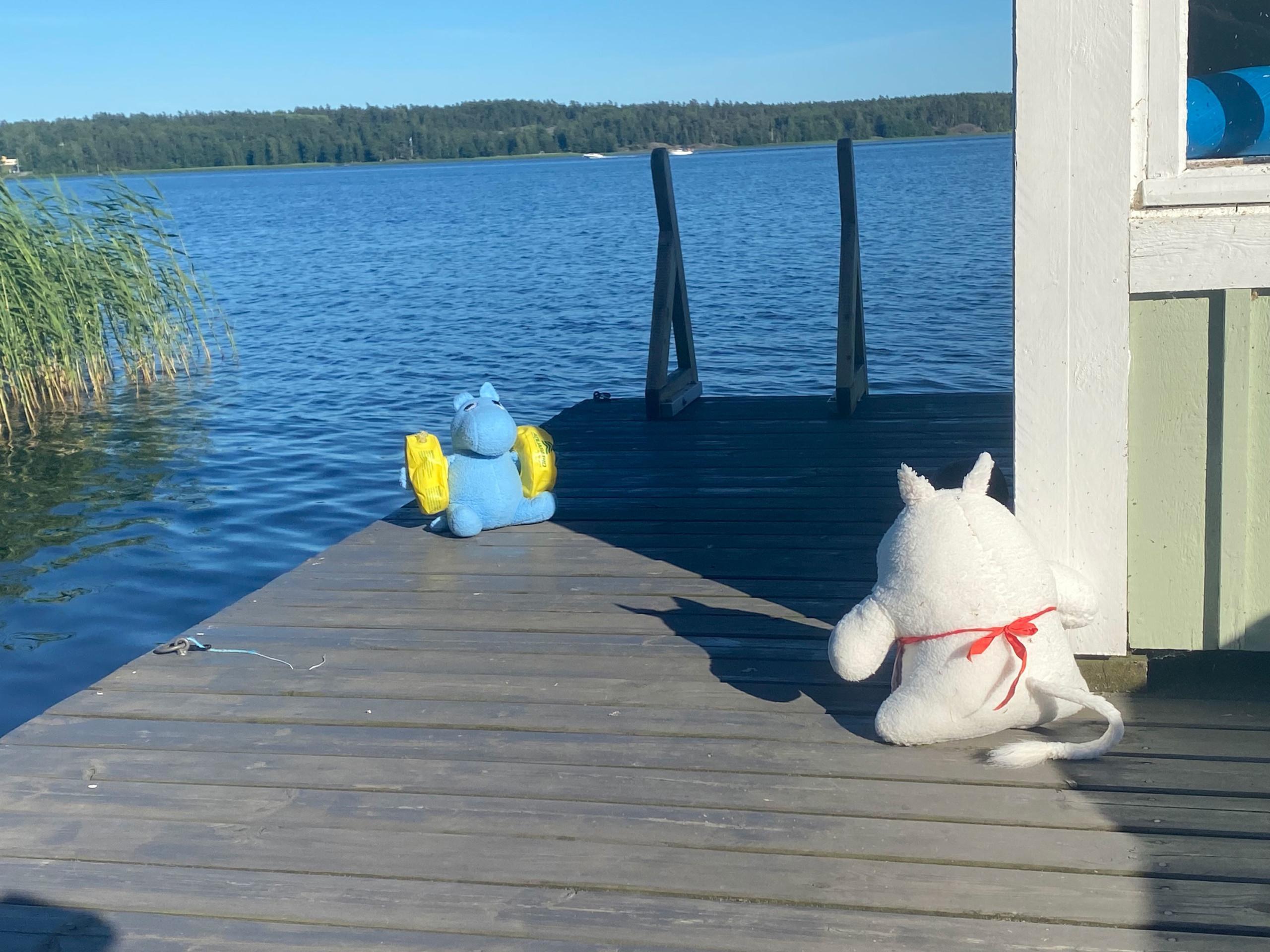

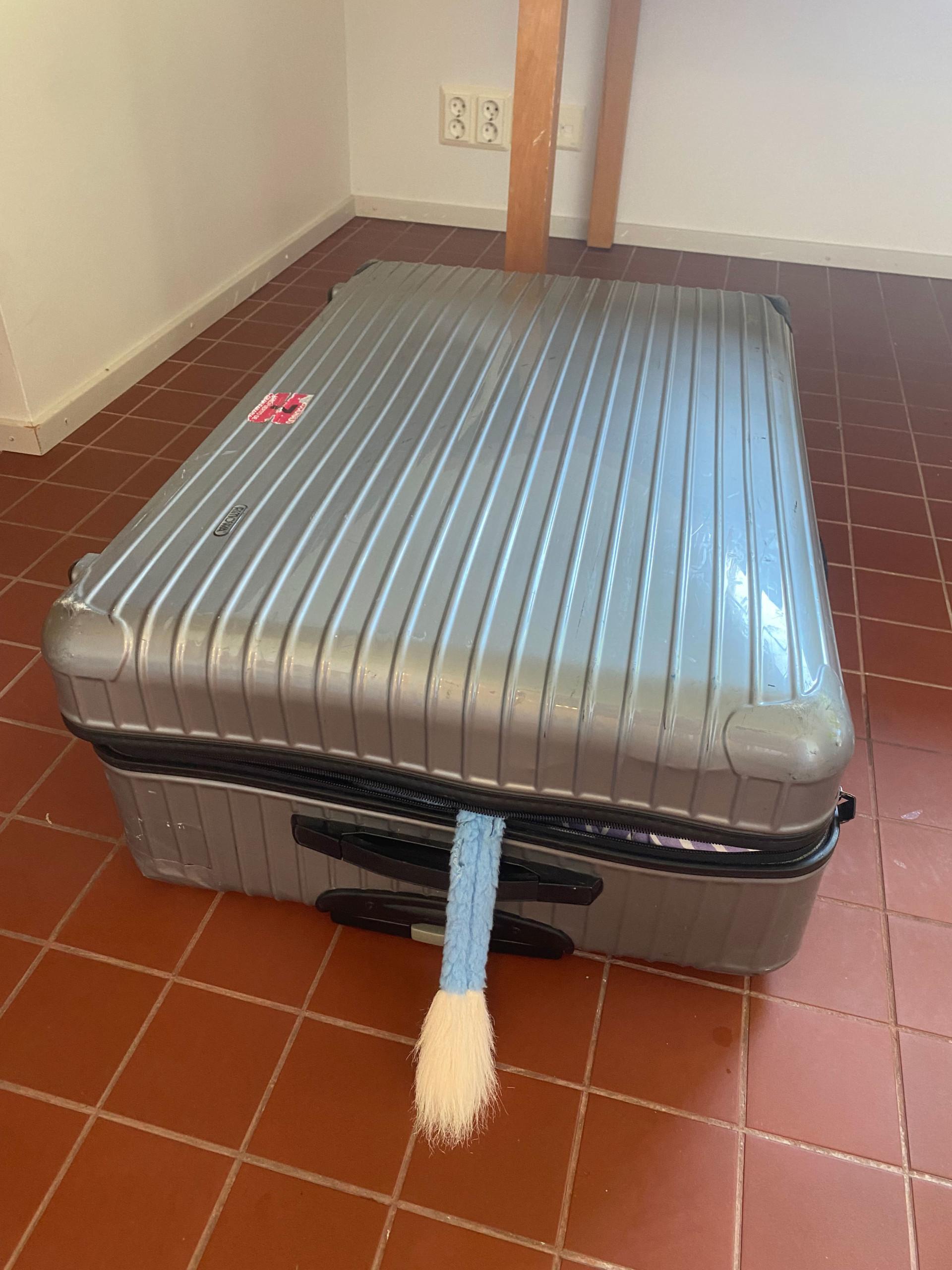
An offering for infinite happiness (Part 2/2)
by Katie Lenanton
Fledgling tontut relationships aside, if the frustrated posts on Suomen Sieniseura [Finnish mushroom association]’s Facebook were anything to go by, 2022 was to be a disappointing year. I’d spent every night in Snäcksund scrolling, seeking the prickle of shroom jealousy that would double as a sign of hope. Upon reflection, my timing was off; many mushrooms came late, if at all, after a small flurry in late July. And the hoped for morel sighting text from Snäcksund never arrived. I consoled myself by reading about mycologist Litt Woon Long’s failure to find morels in her excellent reflective text on mushrooms and grief, The Way Through the Woods. I tried to meditate, or at least breathe deeply, mulling over the knowledge that morels came into being 130 million years ago, coexisting with dinosaurs, and now a Danish startup has figured out how to cultivate them. I guess morels in the supermarket is the not-so-distant future. This news doesn’t do much to quell my desire.

Although it wasn’t to be a morel year, I held faint hope that a mushroomy autumn would arrive. As October approached, I formulated a plan to cook a celebratory feast to thank this small Snäcksund community for hosting me, and offer some form of kindness to the metsätontut.
A sculptural tonttu friend hailed me as I walked past a flea market, and I willingly interpreted it as a sign. I found a beautiful polypore snapped off and discarded on a forest path. Although inedible, it seemed a shame to let it rot while its siblings were living their best decompositional life on a nearby tree. I resolved to honour what shrooms had come my way, and placed it in my basket.



The morning of my arrival, Corinna texted her wise decision to buy yellowfoot chanterelles from the market. I gently dared the metsätontut to prove her wrong, and wistfully documented the mushrooms that had popped up in windows throughout town.
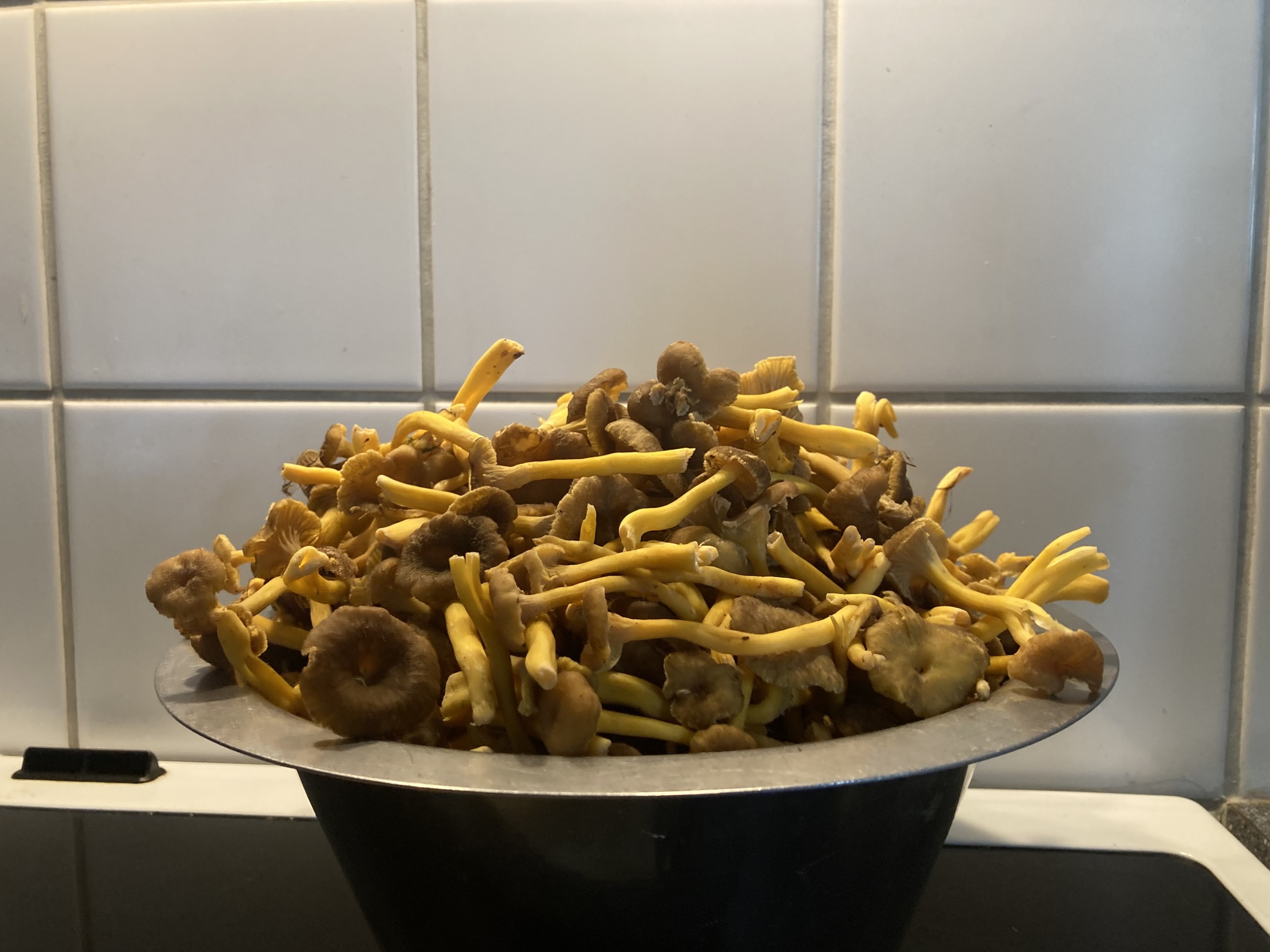


In the kitchen, I deposited a stash of dried morels that I’d wheedled from a friend who’d recently visited Paris, and a vacuum bag of goodness that a friend had posted from Lapland in gleeful celebration of the absolute glut of porcini she’d experienced that year. I thought it better to share the sting of her success, rather than squirrel it away as part of a hopeful pantry altar for mushroom futures.

After a walk in the woods in which I unsurprisingly observed a sparse selection of inedible shrooms, I began preparations for our special meal based on these recipes:
Morel Soup
Mushroom Ragu with Polenta
Mushroom caramel on coffee ice cream
The soup in particular was a highlight, and learning how sodden rice can function as a thickening agent is a minor cooking game changer worth celebrating.



After the meal, we tested the infusions, and I momentarily yearned for that feeling of early springtime possibility that hits when the rowan first buds. I deposited the mushroom trimmings and one dried morel into the belly of the tonttu, which served the dual though unrealised purpose of being a pullopiilo [place to hide a bottle]. We went into the yard, and I dug a hole where the morels had been found last year. Placing the mushroom-filled tonttu-sculpture and the piece of polypore inside, I read out Jane Whitledge’s poetic ode to morels. We took a moment to notice the pleasure of autumn sun on our faces, before proceeding to fill in the hole. I silently encouraged the metsätontut to return some mushroom luck to us all, and to the yard.
Thank you Corinna, Lukas, and M. Raising a glass to all the future mushroom moments, and to infinite happiness. (Katie Lenanton)
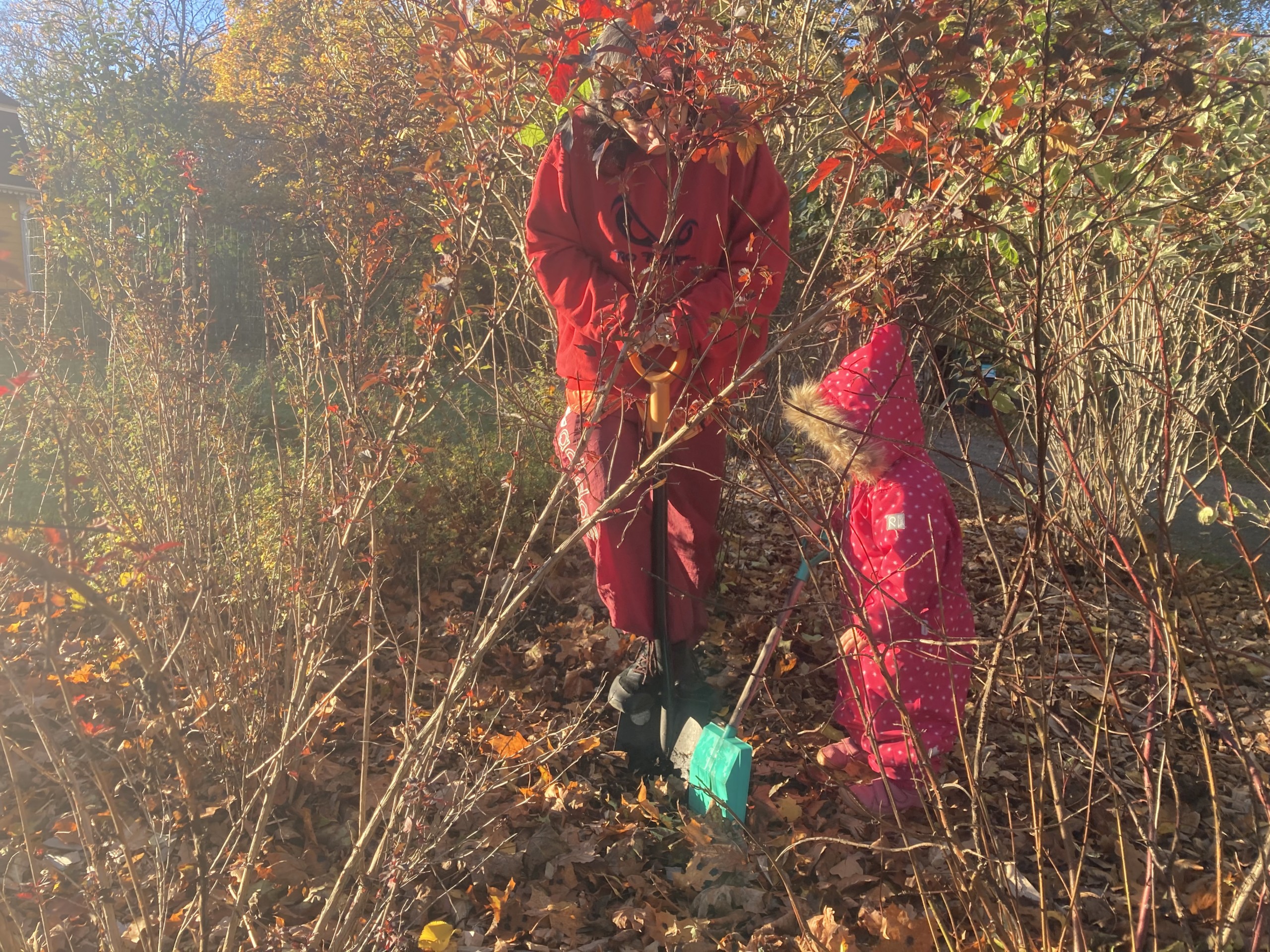
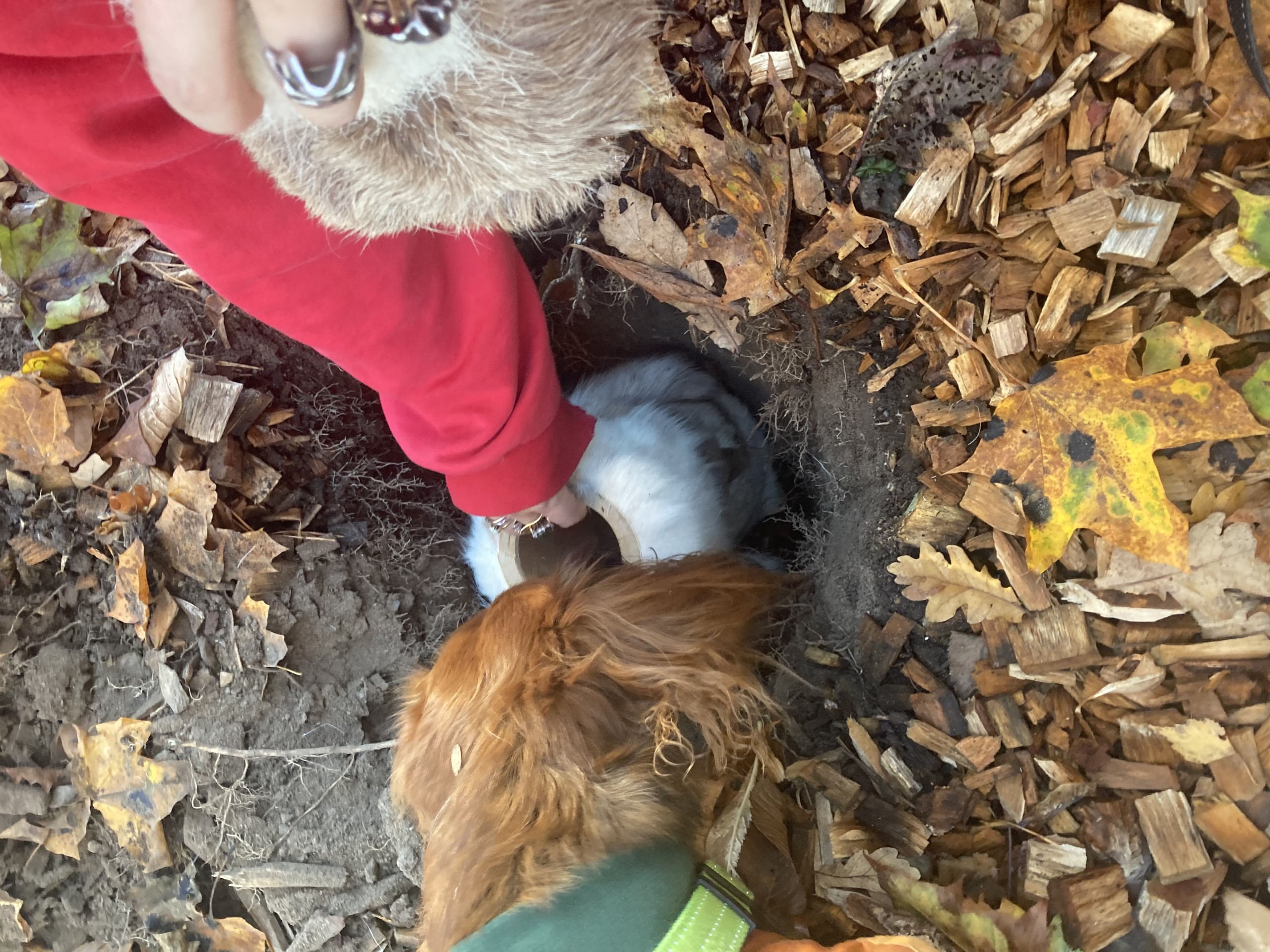
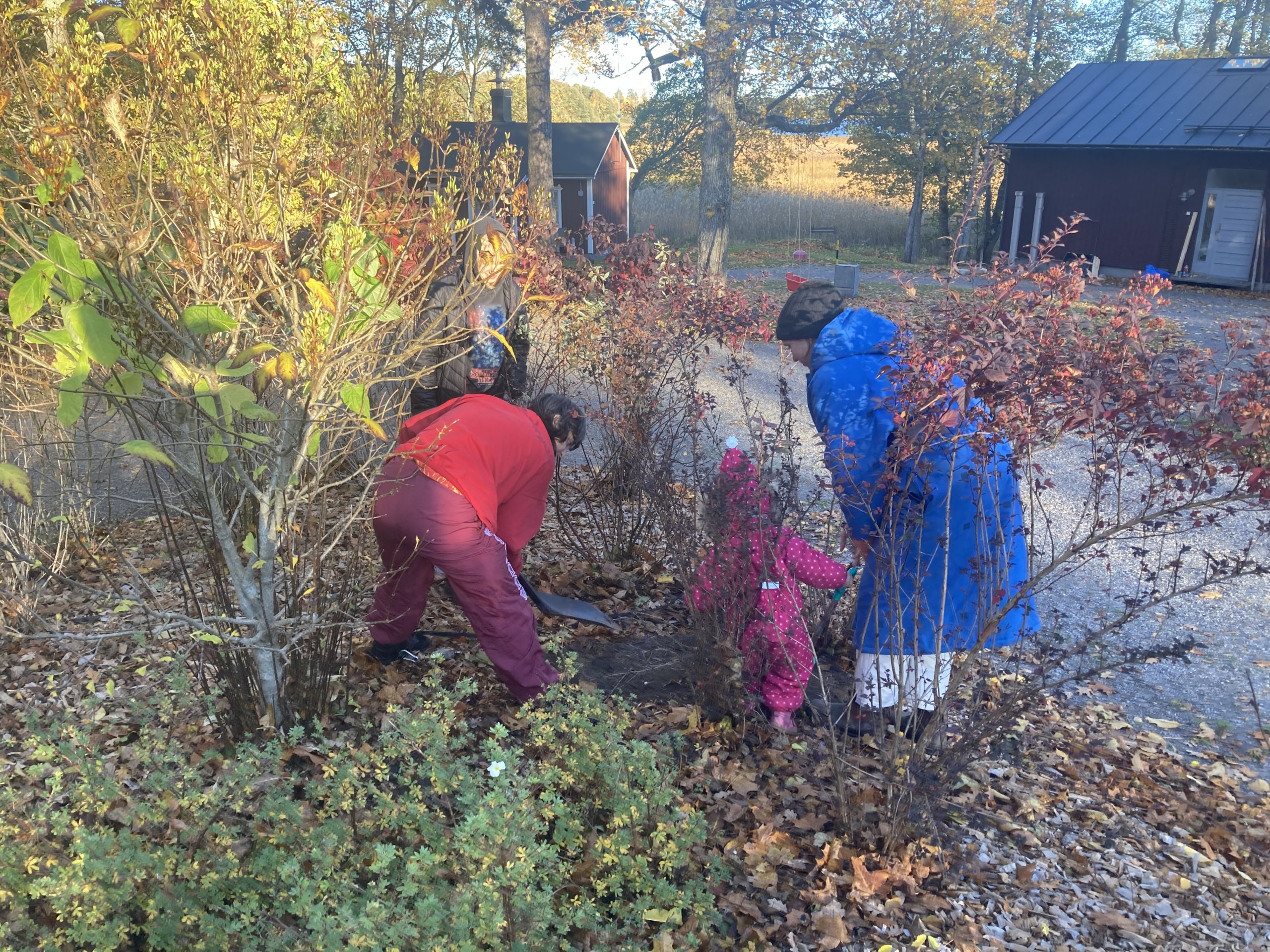
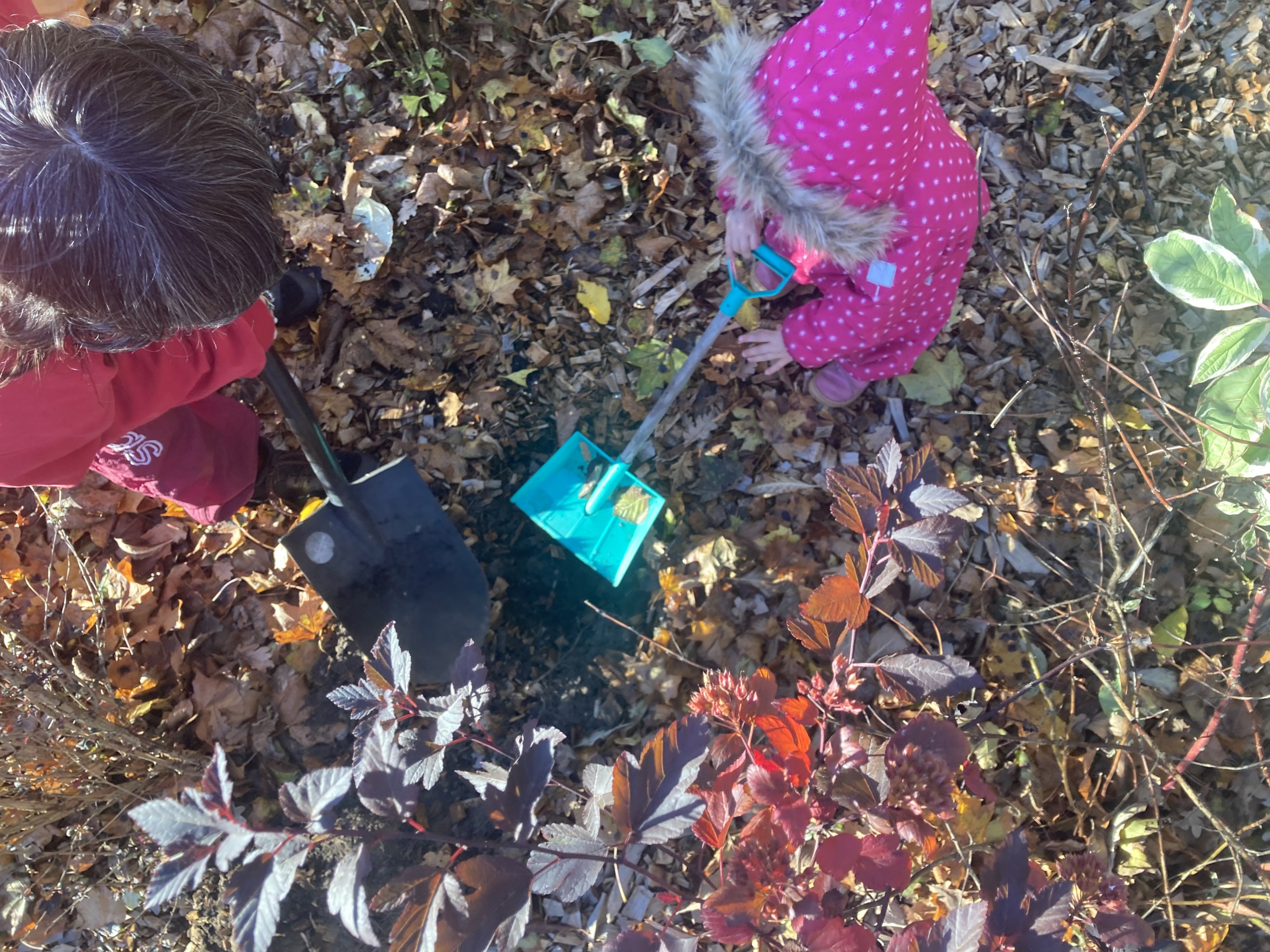
ʟɪɢʜᴛ ᴀғғᴇᴄᴛs ʏᴏᴜʀ ᴇʏᴇs ʙᴀᴅʟʏ
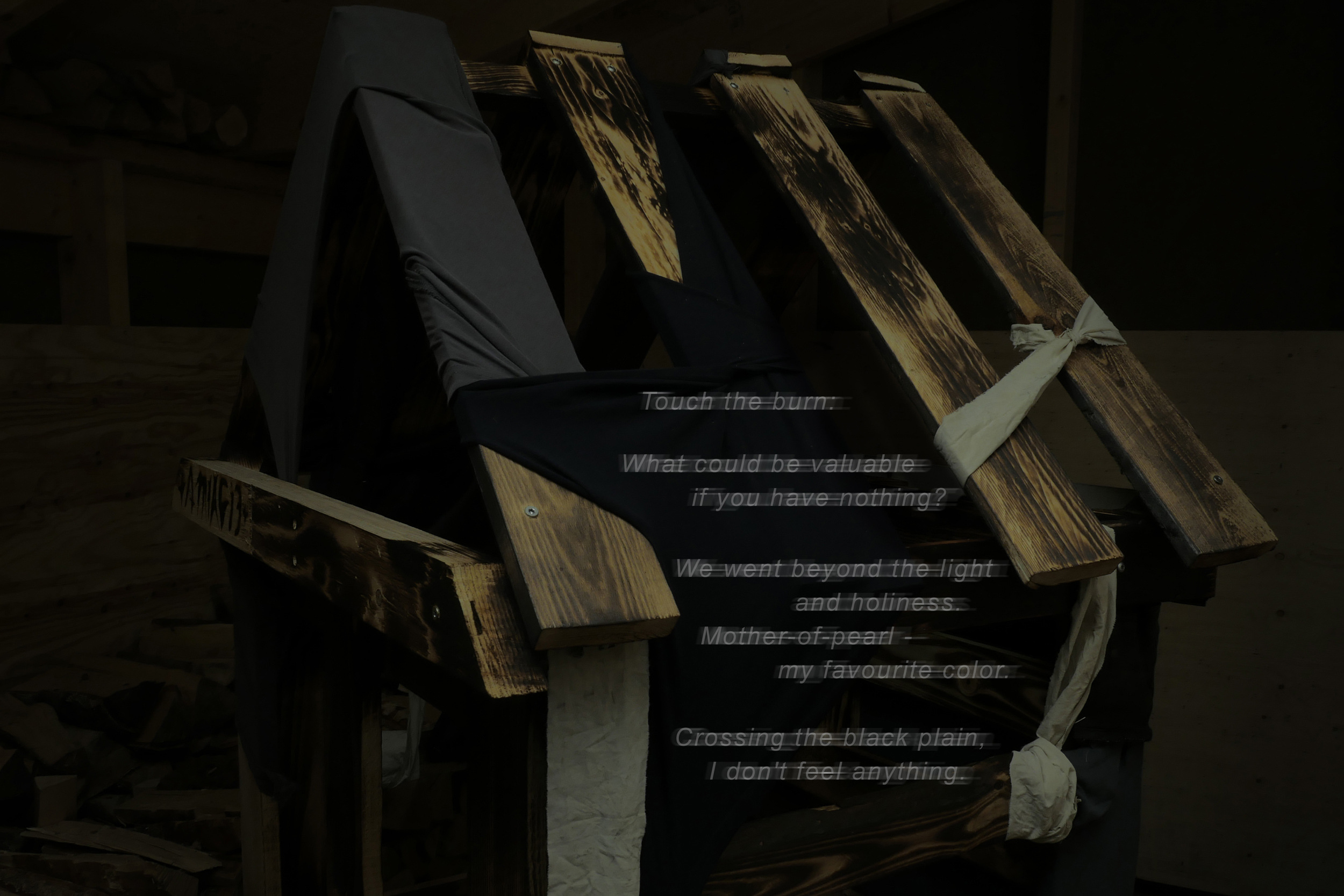
by Anastasiia Sviridenko
wood pallets, textiles, wood burnings, 195 x 61 x 59 cm
The darkness of the winter night is swallowed by deep charcoal. Burned pallets wrapped in scarps. Without memory, in twilight, where it is no longer possible to distinguish once different objects, the “house” turns away from being shelter, towards a dark unconscious that is furnished with fear and aversion. An unresponsive object – memoryless property, dead weight or Nothing. (Anastasiia Sviridenko)
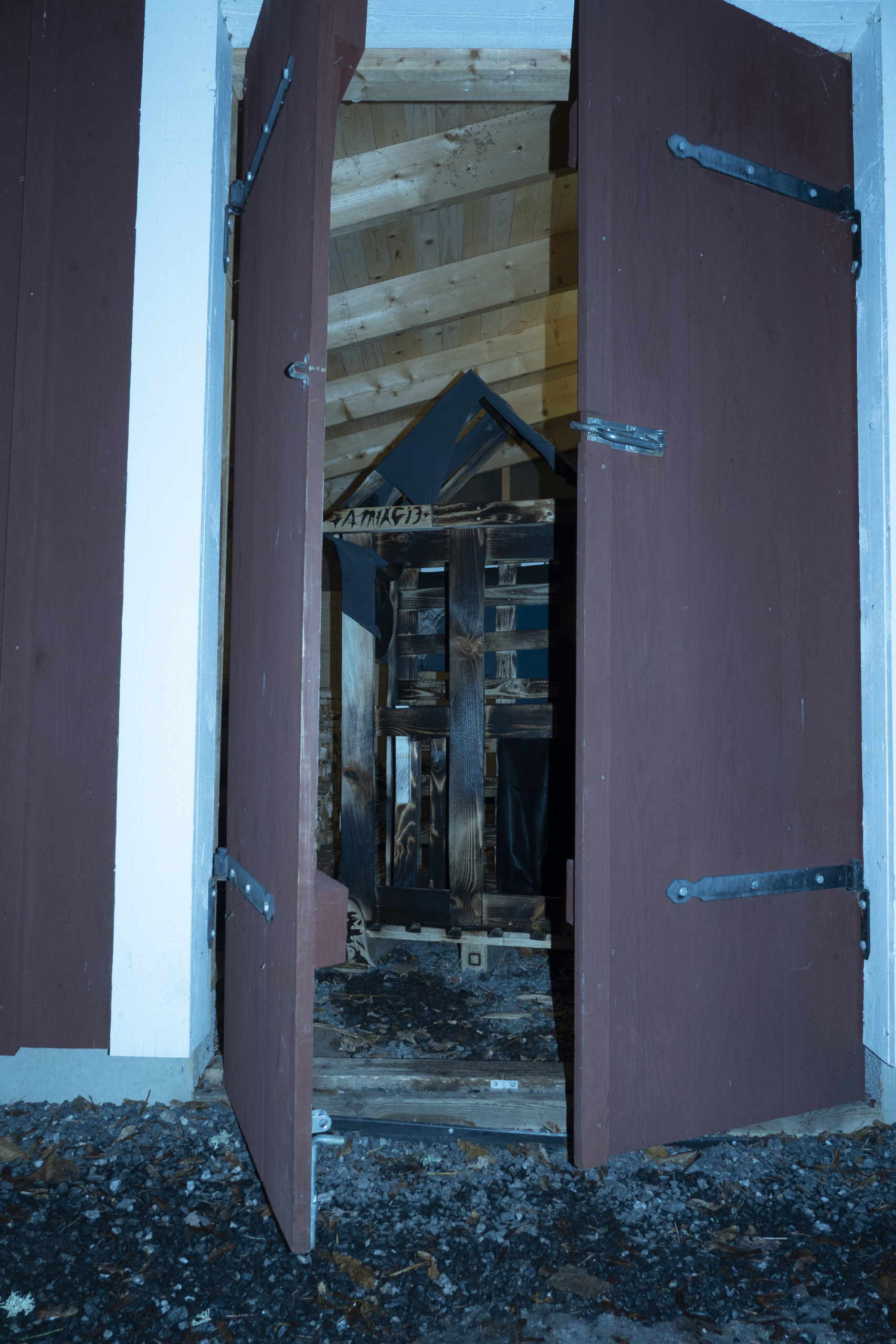
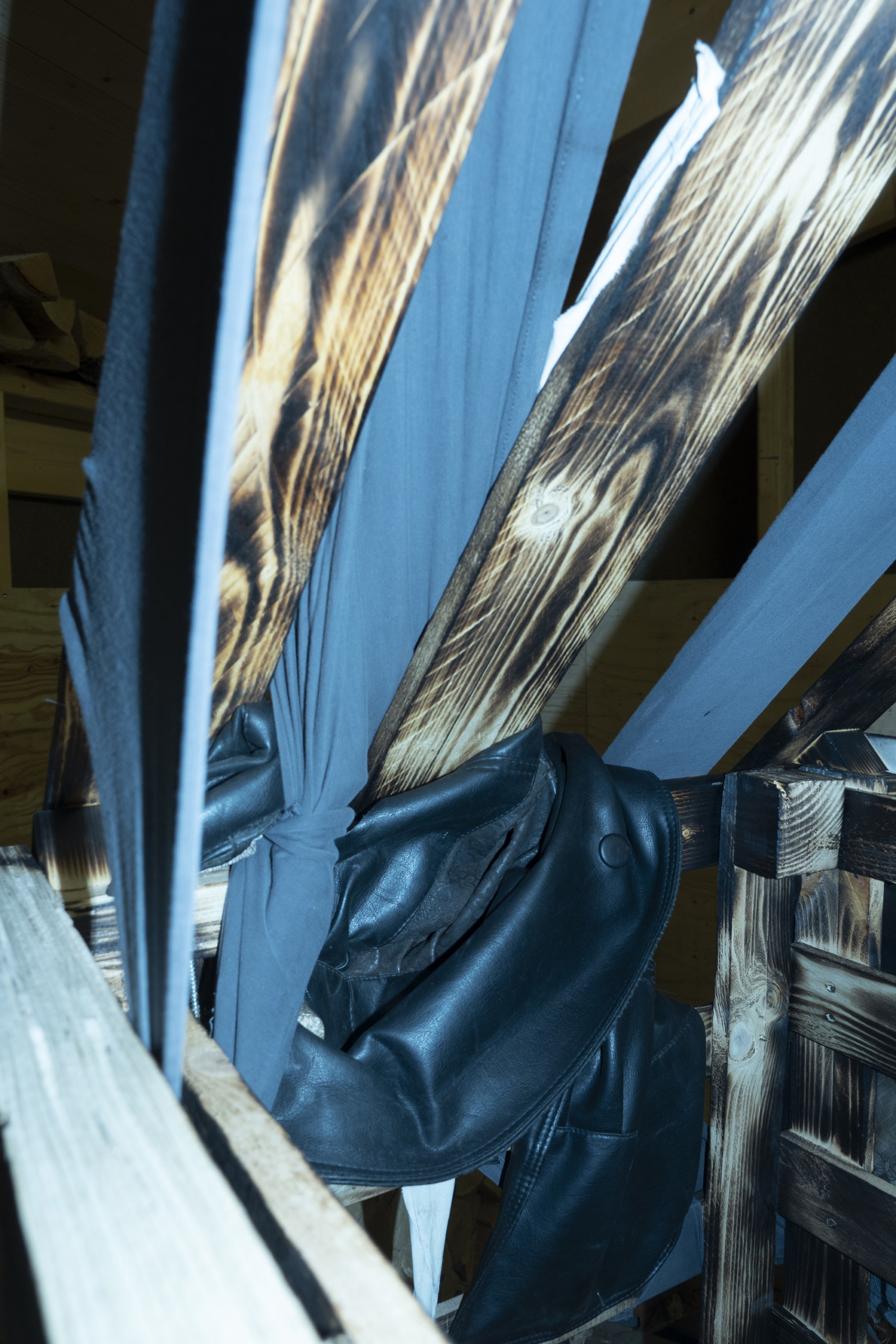
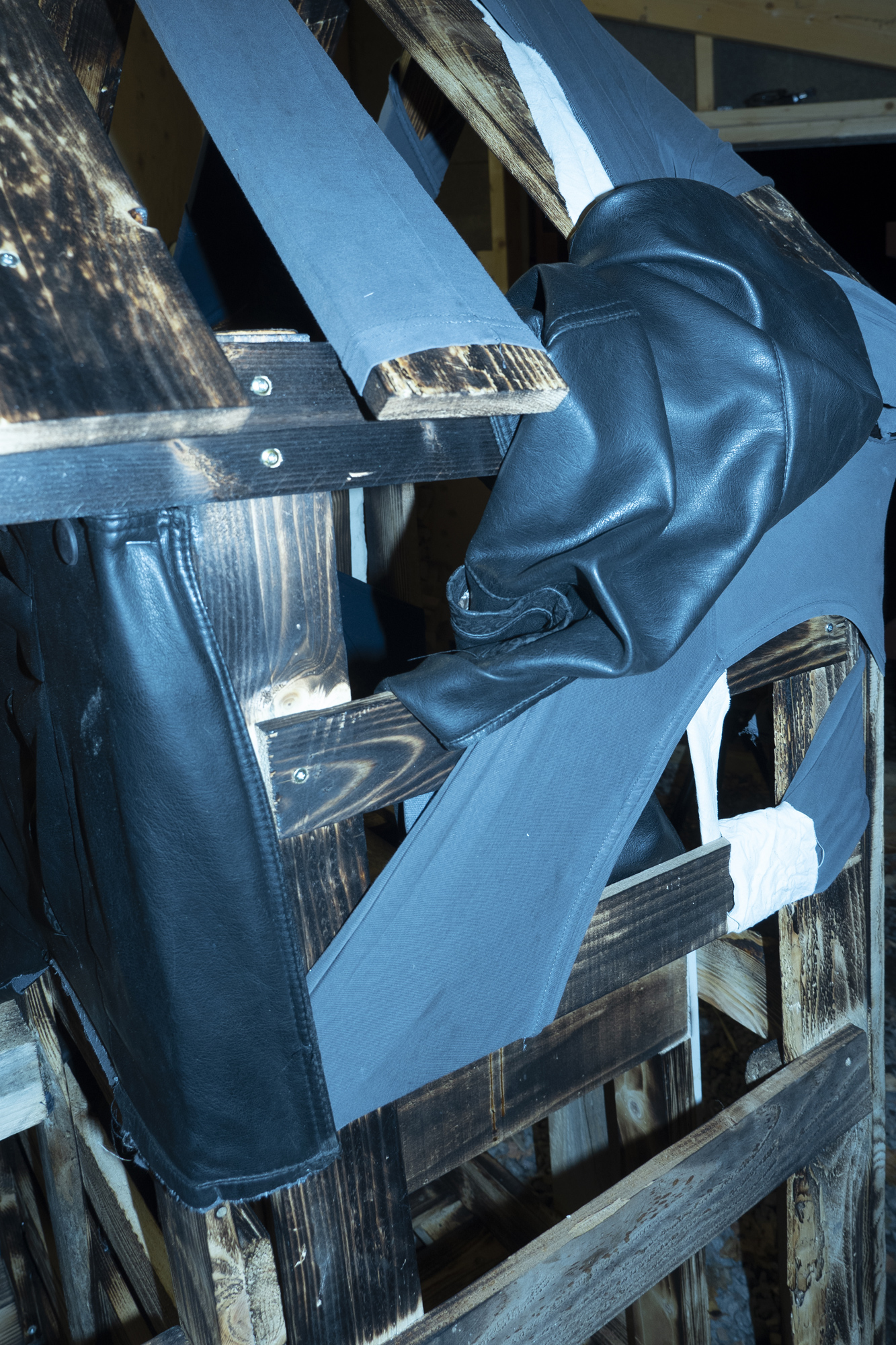

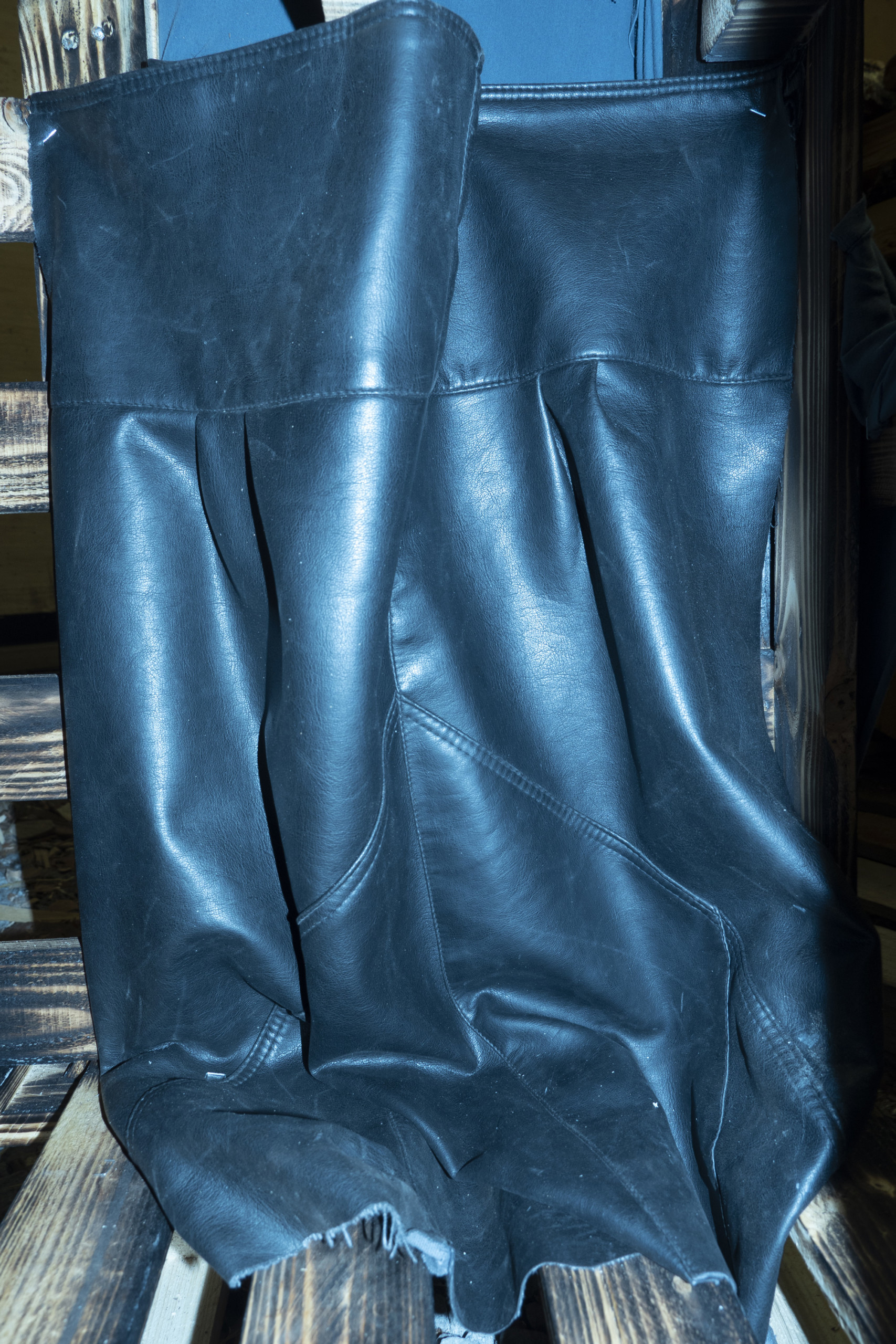
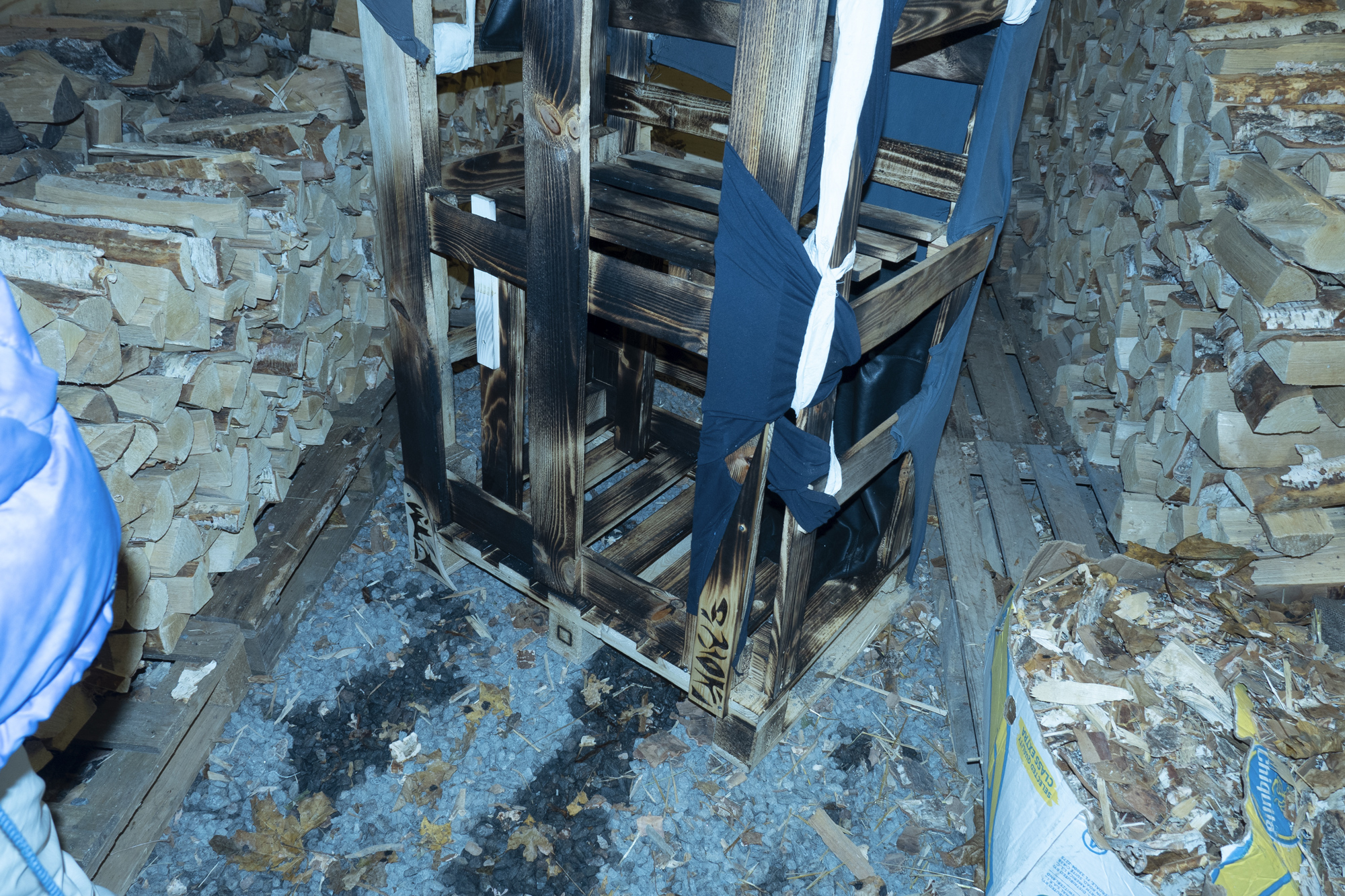

State of Torpor

by Matti Gajek
musical composition, 4:56 min, played in one take on a Casio MG 510 MIDI guitar, recorded and performed by Matti Gajek
I recorded the song in the studio next to the sauna which we often used while thinking about the frozen frog we had just encountered on our daily rounds on the island near the villa. Because frogs are gendered male in the German language, I immediately thought of him as a cheeky little guy. His position was ambivalent. He might have been moving in super slow motion not recognizable for our eyes or he was pretending to be dead, or he was actually dead. That day it was so slippery that it was almost impossible to move forward so we had to put spikes under our shoes. We were still very slow, though not as slow as the frog. He had left tracks in the snow, which is how we knew that he must have been alive at some point recently. Either way, he wasn’t there when we passed the same spot on our way back. Perhaps he had become a delicious frozen snack for a local predator, or he had made it to his final winter quarters. I have always been fascinated by slow motions and by processes that seem to lack forward movement.
Music is about that sometimes. About ways of organizing time that transform it into something spatial like a landscape, or something bodily like a sculpture, but still alive. Amphibians can no longer move when the outside temperature is below ten degrees. Their inner processes are synchronized with large outside forces impossible to control, planetary motions, weather. I can relate to that. And yet I prefer to think that the frog was toying with us. Playing a game of stillness, remembering in his body the feeling of being able to jump. Music is about that as well. (Matti Gajek)
With thanks to Mica Ström for lending us his marble guitar.



”Älästä sie houkka ammu haltian lintuja!”
(”Don’t you go shooting the elf’s birds, you fool!”)

by Savu E. Korteniemi
site-specific artwork from plywood, wood, shellac, ground pigments, yarn
The artwork can be touched carefully. The yarn attached to the bird moves its wings.
Lapland as a habitat and home region has led me to think about those topical societal, ecological and cultural meanings that are connected to the north as place and direction.
Since 2018 I have worked with art projects under headline The Last Ones, that deals with connections between north and death in Finnic mythology. When I oriented myself in this theme, I find the expanding weaving of myths, images, historical events, and power structures.
At this moment I’m working with project that goes by the working title Unilintu (lullabird or dream bird). The name refers to bird appearing in Finnish lullabies, that goes by the name Nurmilintu, the Bird of Grass. This bird lives underground – under grass-, in the land of death. Forest birds have been traditionally seen as the ambassadors of death in rural societies, where the edge of forest represents the fine line between the world of humans and beyond. The strongest connection to the beyond was credited to crossbreed birds. Forest birds appearing in the home yard were seen as especially strong omen.
My father’s side of the family speaks the Torne Valley Finnish dialect. The equivalent language on the Swedish side of the border is called Meänkieli, which also has the official minority language status in Sweden. J.R.R. Tolkien has said that language is mythology and mythology is language. Language is not just for communication since each language also carries along the whole world in it. That is why even the smallest of languages is irreplaceably valuable.
Language is more than just words. It is also sounds, movement and silence. Each language has its own ecology, species, neighbors, weather, and sources of livelihood. Each language has its rhythm, breath, and time. Each language can show the world in a different light.
The North can also be seen as the crossing point for a variety of worldviews. I was brought up in the conservative Laestadian revivalist movement. I have found it interesting how in Northern areas even the most devoted Christianity has always given space to other creatures of the afterlife.
The black grouse bird mobile I brought to Pihalla was named after the incident in my brother’s yard, when a flock of such birds appeared there. My brother shared some photos of them in our Whatsapp family group. That’s when my father replied: ”Don’t you go shooting the elf’s birds!”
Later on, I asked my father, why the black grouse flock in the yard would belong to an elf (haltia) and who is this elf? “That’s how it’s always been said” he replied.
I borrowed the form for my black grouse from the bird mobiles, which have gentle, rounded forms and peaceful flight, that resemble us from the lullabies. The structure of this bird is simple, but it demands accuracy to make it fly. It occurred to me how the balance is also the result of different relationships: distance to mass, yard attachment point locations to each other. The balance is never perfect. Therefore, my black grouse’s flight appears slightly rickety. But perhaps it is the first one of the flock. (Savu E. Korteniemi)
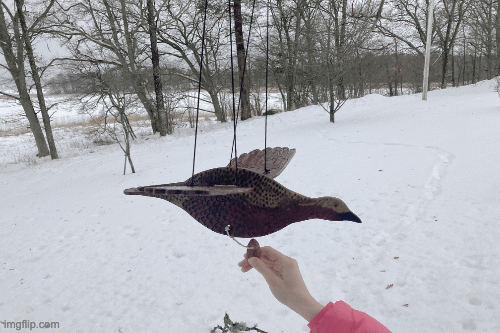
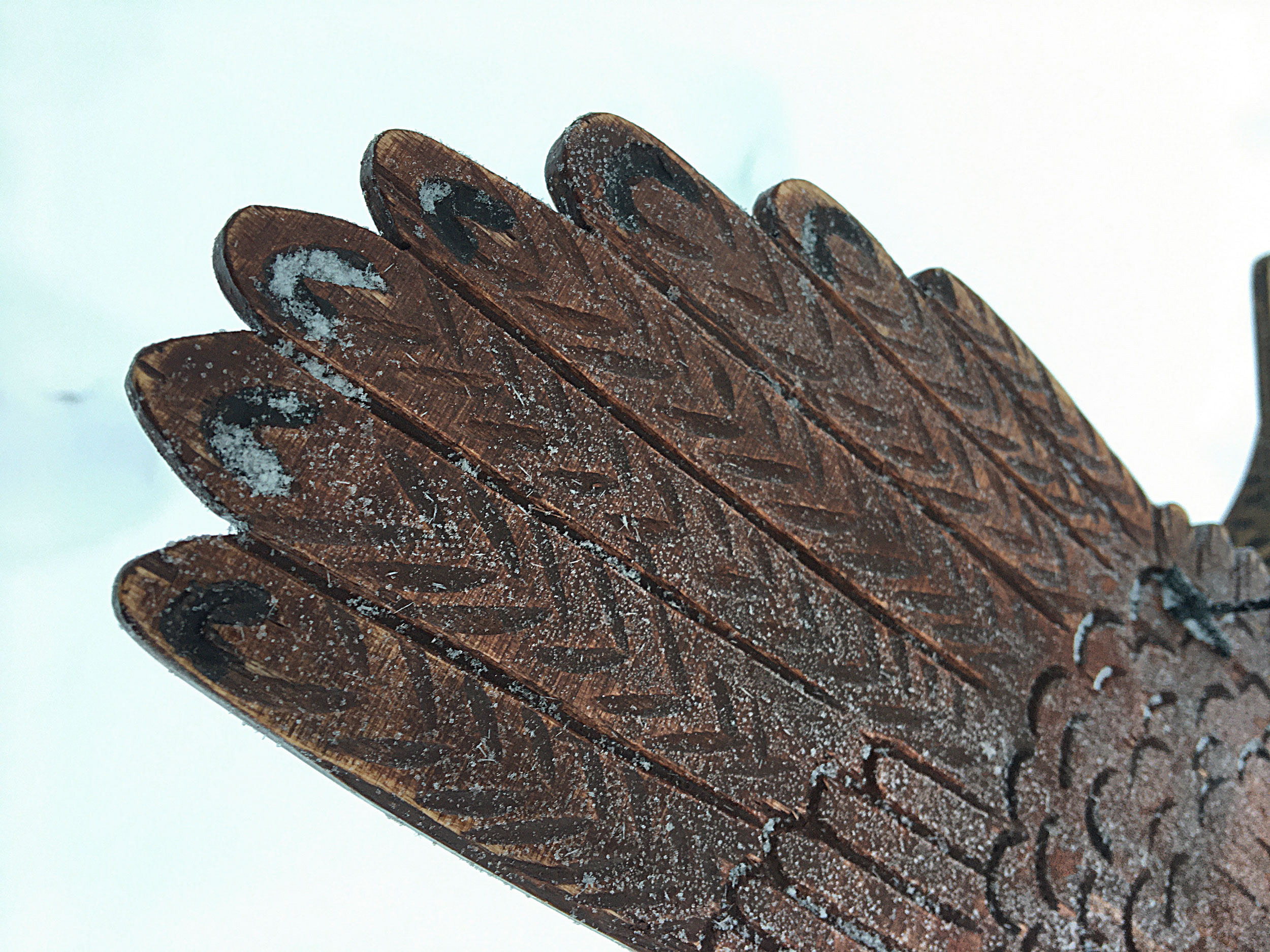
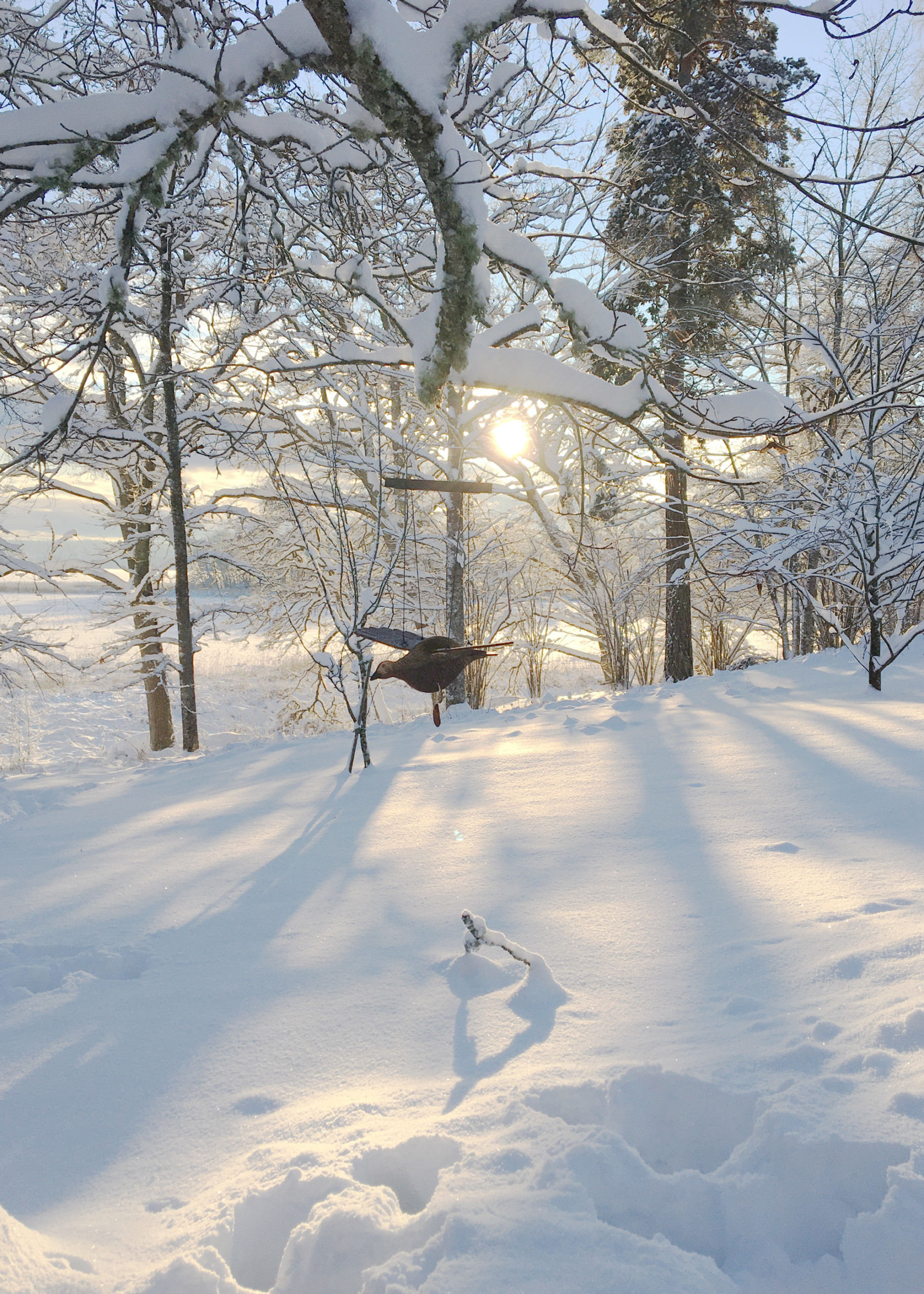
Contributors:
Æpis started working together since 2018 while exploring what it means to live a healthy and loving relationship. They consist of Espen Melin Hagedorn, Alice Peragine, a lot of patience, experiment, improvisation and embracing failure as part of their process as they go along. A beginning was marked through their piece for Folgendes at HFBK, Hamburg, called Potential Dwelling Situation (2018) as a suggested space for gathering in the installation blurring the lines between audience and performers. Alongside numerous collaborations developing performances and installations together for Translucent (2018) at VIS, Hamburg, Please hold the Line- Thank you (for holding) (2021), at Lothringer 13 Halle and Soft Roader (2021) at Haus der Kunst, they are entering a new phase of collaboration navigating a precarious life as freelance artists in a committed relationship confronting subjects of death and loss and what it means to be a living species on a damaged planet trying to negotiate an artistic practice coming from a place of fragility and humility.
Livio Casanova is a swiss artist working with and on textile. Livio’s studio practice is informed by his reading research which is propelled by personal interests and curiosity. Recent exhibitions include Dorset Place, Brighton CCA, 8. Salon (Hamburg), Württembergischer Kunstverein (Stuttgart), Institute For Provocation (Beijing), Yellow Brick (Athens) and Kunsthalle Bern (Bern), among others. Livio is part of the Artist-Run Space Milieu (Bern).
Matti Gajek (DE) produces and performs electronic music under the stage name Gajek. From an East German perspective Gajek inscribes himself into the progressive myth of Krautrock by shifting the focus to a different side of German history marked by the material traces of the Cold War. In 2022 Matti Gajek launched Socialist Realness on UK radio Resonance Extra, a mix series focused on rare, mostly unknown avant-garde and electronic music produced in the GDR and shortly after the fall of the Berlin Wall. In 2021 he joined forces with Drone Operatør and artist Ian Bruner to collaborate on a new band project called SIM CARD HØLDER which was released on FaltyDL’s Blueberry Records. Gajek has published records on Throttle records, Monkeytown and Infinite Greyscale. He composes music for films, theatre, exhibitions and performances, most recently for the online exhibition Chernobyl Papers by New Scenario. Gajek has performed his music in venues such as TraumaBar und Kino, Berghain, Printworks London. Matti Gajek lives and works in Berlin.
Savu E. Korteniemi (they/them), born 1986, is a visual artist and independent writer, living and working in Lapland. They hold a Master Degree of Fine Arts from the University of Arts Helsinki, Academy of Fine Arts (2013). Moreover, Savu E. Korteniemi is a co-curator of the Young Arctic Artists exhibition series. Savu in their artistic practice uses mostly sculpture and drawing. During their artistic process, Savu also puts a strong attention on writing and notation practice as a tool to reflect and discuss questions that arise during their research. They are particularly interested in objects and how one can give shape to things out of reach. The making of concrete pieces is analogous to language construction; in that sense thinking is also three-dimensional. Like objects, thinking is silent.
Curator Katie Lenanton’s research combines feminist support practices, reciprocity, and care with her love of foraging and conversation. In 2018 she co-founded Helsinki-based intersectional feminist organisation Feminist Culture House, a non-profit collective whose mandate is to work with and for underrepresented artists and arts workers. Katie also maintains an independent curatorial practice, researching how to develop a sustainable freelance curatorial practice, while harnessing affective economies like generosity, love, and support. This work is often realised through exhibitions, social practice, and publishing forms.
Anastasiia Sviridenko, born 1996 is a Ukrainian artist. She graduated in fine arts from the Moscow state academic art institute named after V.I.Surikov of Russian academy of arts in 2019 and works in various media, including painting, graphics, and sculpture. Her practice is based on working with relationships and connections between human emotions, information flows, economics, history, literature and the vitalistic pulsation of material things. In her work, Sviridenko resorts to the aesthetics of horror as a tool for working out collective fears of the incomprehensible.
Polly Wright is a Brighton (UK) based curator and researcher. Polly is currently Programme Producer at Brighton CCA and Programme Co-ordinator of Incidental Unit, the third iteration of Artist Placement Group.
A project by Corinna Helenelund and Lukas Malte Hoffmann.
All images courtesy of the contributors.
